Mary Anne Yarde's Blog: The Coffee Pot Book Club , page 184
February 25, 2018
A Viking Age Mystery By Michael Wills #history #Vikings @MWillsofSarum
A Viking Age Mystery
By Michael Wills
Driving west from Stockholm, I found that I could leap-frog from island to island in the huge Lake Mälaren by using the free car ferries. However, when I came to the island of Adelsö, there was no alternative but to park my car and seek the well-hidden jetty from which a small passenger ferry would take me to my destination – the island of Björkö, the island of birches.
Today, Björkö is about 4 by 1.5 kilometres. In the Viking Age, the island was only half as large. This strange geographical phenomenon is caused by the fact that the land has risen. During the Ice Age, there was a 3-kilometre-thick ice sheet over this region. The weight of the ice depressed the land. As the ice melted, the land, no longer encumbered by the heavy ice, rose, and it is still doing so.
My journey was taking place in late September, well outside the tourist season. The only other passenger on the ferry, an elderly woman, told me that she and a few others lived on Björkö year-round, and that for much of the year, they were totally isolated and that this ferry provided their only transport to the outside world. Things were very different twelve hundred years ago.
Several market towns were established on the northern periphery of Europe in the eighth century. The first was Ribe in Denmark, thereafter Staraya Ladoga in Russia, Hedeby in what was Denmark, (now in Germany and called Haitabu), and the town of Birka on Björkö.
Birka was founded by an unidentified King in the first half of the eighth century. He was a powerful landowner who it is believed, resided in a mansion called Hovgården, (traces of which have been found), on the island of Adelsö, just a hundred yards from where I had parked my car. Powerful landowners had realised the value of commerce, and they commissioned the building and furnishing of ships for trading voyages. They could also equip men to protect their ships, for warfare and plundering raids.
There was a huge demand in southern Europe and later in the Middle East, for northern European hides and furs. In what is today Sweden, the ancestors of the Sami who lived in the high mountain regions far to the north and were known in the Viking Age as “Finns”, migrated seasonally between places of winter and summer residence. They were hunters and trappers, and they traded their goods with the farmers of the Mälaren region. The farmers, in turn, traded these with foreigners who visited the area.
The king of Adelsö sought to formalise this trading, and thus founded Birka, the most important commercial centre north of Denmark. The great attraction of Birka for merchants was that in a time of great insecurity and lawlessness, it was protected and provided a safe environment for them to do business. Outside of the harbour, there are signs that it was defended from attack by rows of poles sticking up vertically from the seabed. A high, 880-metre long rampart was built around the town with a wooden superstructure. There were six gates in the rampart and no doubt these were guarded. There is evidence of the presence of a large garrison of trained warriors. Traces of their barracks have been found.
Urbanisation was something completely new in the Viking world, but the town appears to have grown very quickly. The Houses were built, most of them wattle and daub, but some with horizontal planking, according to a town plan. They were quite small, with combined living quarters and workshop areas, and all had access to jetties where trading ships could berth. It is estimated that at its peak, the population of the town was around 1,500.

The prosperity of Birka grew and attracted a multitude of artisans who could make and trade their wares in safety. There were jewellers, silversmiths, glass bead makers. Comb makers, carpenters, bronze casters and blacksmiths, all making goods which found their way into southern Europe and beyond. Archaeological discoveries, including a hoard of 450 Islamic coins prove that there was a lively trade with the Middle East. During the early Birka period, until the mid-800’s, Arabic goods were imported along routes over the Caspian Sea and through the Caucasus, the kingdom of the Khazars. In the course of the ninth century, trade routes were opened further east to Tashkent and Samarkand. Merchants brought wine, spices, silks and polished beads to exchange for hides and furs. They also brought silver, in the form of coins – dirhams. The coins themselves did not have a face value, their worth was calculated according to weight.
In southern Europe, there was much concern that the inhabitants of this important town were not Christian. In autumn 829, Anskar, a Frankish missionary, landed at Birka and began an attempt to convert the followers of Tor, Odin and the other Norse gods. He was unsuccessful and left the island two years later. It is suggested that a small church was built, but its remains have never been found. Anskar made a second futile attempt in 852, but it would be another two hundred years before the inhabitants of this region were all Christian.
Archaeologists have discovered evidence showing that there were many pre-Christian religious rituals practised by the inhabitants. This is particularly so in the case of death. There are over 3000 graves near the ruins of Birka, 1600 of these in the form of mounds are clearly visible today. Excavation of some of these has revealed a lot about Viking Age beliefs regarding death. Many graves had articles which it was considered the dead would need in their after-life journey, these included axes, cooking utensils, knives, jewellery and combs. The most prominent chamber graves must have been those of wealthy men and women for these contained horses, dogs and bodies wearing richly decorated clothing.
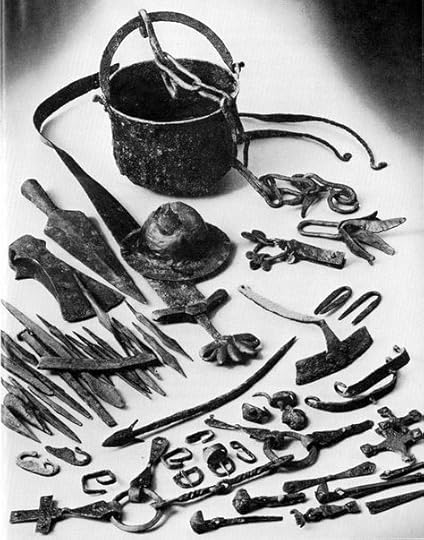
Wandering around the remains of the once thriving commercial centre it is difficult to visualise how things once were. The bustling harbour would have been full of ships, merchants from all over the known world, dressed in the garb of their own countries, would have been selling and bartering in whatever common language they could use. The workshops attached to the houses would have been hives of activity as artisans were busy producing their wares. No doubt there were representatives of the king, keeping a watchful eye on proceedings and the garrison would have been deployed to keep order. It was clearly a very successful and prosperous town.
And then, within a very short period, at the end of the ninth century, Birka was abandoned. Why?
Archaeologists insist that there are no signs that the town was plundered or burnt, for there would otherwise be a layer of ash in the soil. Was there an epidemic? Did travellers from abroad bring some illness which decimated the population? Is it possible that the king ordered an evacuation of the town in favour of his new capital at nearby Sigtuna? Whatever the cause, by the beginning of the eleventh century the only humans left in Birka were those in the graves, the remains of whom, as they are excavated, are helping to piece together the story of the town and perhaps one day may reveal what really happened.As the little ferry motored slowly back to Adelsö, I looked over the stern and watched as the high hill which was the garrison’s lookout post, disappeared into the mist. I knew that there were stories to be written about this mysterious place and I am pleased that researching for them took me back there four times.

Every July, Viking Age re-enactors from all over Northern Europe gather at Birka to commemorate the heritage of the town.
Michael Wills
 Michael E Wills was born on the Isle of Wight and educated at the Priory Boys School and Carisbrooke Grammar. He trained as a teacher at St Peter’s College, Saltley, Birmingham, before working at a secondary school in Kent for two years.
Michael E Wills was born on the Isle of Wight and educated at the Priory Boys School and Carisbrooke Grammar. He trained as a teacher at St Peter’s College, Saltley, Birmingham, before working at a secondary school in Kent for two years.After re-training to become a teacher of English as a Foreign Language he worked in Sweden for thirteen years. During this period, he wrote several English language teaching books. His teaching career has included time working in rural Sweden, a sojourn that first sparked his now enduring interest in Scandinavian history and culture – an interest that after many years of research, both academic and in the field, led him to write Finn’s Fate and the sequel novel, Three Kings – One Throne. His interest in teaching children led him to start writing stories for young readers and in 2015 he published the first two of a quartet of novels for 8 -13 year-olds in a series called “Children of the Chieftain”.
Today, Michael works part-time as Ombudsman for English UK, the national association of English language providers. Though a lot of his spare time is spent with grandchildren, he also has a wide range of interests including researching for future books, writing, playing the guitar, carpentry and electronics. He spends at least two months a year sailing his boat which is currently in Scandinavia.
You can find out more and stay up-to-date by visiting his website.
Children of the Chieftain : Betrayed
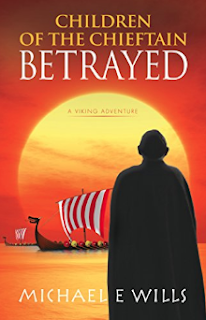 When the town of Birka is raided by the most fearsome of Vikings, the Jomsviking, many of the people are captured. A pair of orphans are forced to take action and lead their friends in a desperate attempt to rescue the captives. But not all of their allies are as loyal as they should be. The brave children are betrayed and find themselves in grave danger of captivity, and risk of being sold into slavery.
When the town of Birka is raided by the most fearsome of Vikings, the Jomsviking, many of the people are captured. A pair of orphans are forced to take action and lead their friends in a desperate attempt to rescue the captives. But not all of their allies are as loyal as they should be. The brave children are betrayed and find themselves in grave danger of captivity, and risk of being sold into slavery.Amazon
Published on February 25, 2018 23:00
February 23, 2018
#NewRelease ~ Misfortune of Vision (Book #4 in The Druid’s Brooch Series) #historicalfantasy #mustread @greendragon9
Misfortune of Vision Book #4 in The Druid’s Brooch Seriesby Christy Nicholas
Historical fantasy set in 12th century Ireland
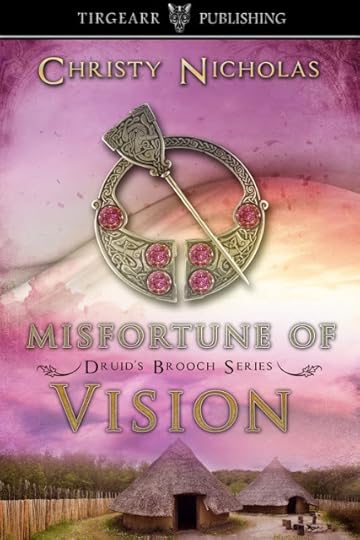
Excerpt
As they entered the bustling market, many vendors and shoppers taking advantage of the rare bright winter day, Orlagh saw more soldiers than normal. Cu-Uladh went off on an errand of his own while she bought some items at the tanners. He returned shortly with a smug grin.
“I’ve something for you.” He rooted in the leather pouch on his belt and came up with something that shone in the sun.
Holding it up, Orlagh saw a gleaming green stone. He handed it to her and she peered closely at the swirling surface.
“It’s Connemara green marble, so the man says. I thought you used so many different things in your poultices and potions, a legendary stone might be of use to you.”
It was absolutely silly to feel tears burn behind her eyes. She swallowed them and nodded at him.
“Thank you for the gift, Cu-Uladh. It was a kind thought.”
He grinned, showing a missing canine. “I’m glad you like it. That’s not my only gift, though.”
She raised her brows. “Oh?”
“A gift of knowledge, as it were.”
“Do tell. Or do I have to beat it out of you?”
He laughed deep and long. “I’d love to see you try! No, no beating necessary. I have information related to what you’ve told the Chief.”
Orlagh looked around in alarm. “Cu-Uladh! This is not the place to be speaking of such things!”
“It’s no secret, truly. It’s common knowledge around here now. We’ve been away several days, but the gossip is everywhere. The Normans are coming north. Most bets are on them coming here.”
“Here? Blast it all to the deepest hell. Why did I have to be right?”
“Well, it’s a good thing you were. My Chief was in no mood to muster his soldiers without that particular Vision from you. At one point, he spoke of leaving, but between the rumors and your own words, he had no choice. He’s at least pulled in favors and has called on a few allies to help. With luck, they’ll be here before the Norman army.”
“Army? How many are marching then?”
“No one is certain, but the rumors say over four hundred men, but who knows.”
A glimpse of bright colors made her steady her gaze. Several well-dressed men had entered the market. One in particular she recognized when he stopped dead in front of her.
An Dunn Sléibhe stood with his arms crossed over his chest, with the Bishop looming behind him. “So you return, Orlagh. I’d wondered if you’d gone off forever.”
Links for Purchase
About the author
 Celtic Fairies, Fables, and Folklore! Bestselling author (top #100 Amazon Canada, #1 in Paranormal Fantasy, Amazon Canada)
Celtic Fairies, Fables, and Folklore! Bestselling author (top #100 Amazon Canada, #1 in Paranormal Fantasy, Amazon Canada)Christy Nicholas, also known as Green Dragon, is an author, artist and accountant. After she failed to become an airline pilot, she quit her ceaseless pursuit of careers that begin with 'A', and decided to concentrate on her writing. Since she has Project Completion Disorder, she is one of the few authors with NO unfinished novels.
Christy has her hands in many crafts, including digital art, beaded jewelry, writing, and photography. In real life, she's a CPA, but having grown up with art all around her (her mother, grandmother and great-grandmother are/were all artists), it sort of infected her, as it were.
She wants to expose the incredible beauty in this world, hidden beneath the everyday grime of familiarity and habit, and share it with others. She uses characters out of time and places infused with magic and myth. Christy Nicholas loves to hear from readers. You can find her… Website Blog Facebook Twitter Publisher <!-- /* Font Definitions */ @font-face {font-family:"Cambria Math"; panose-1:2 4 5 3 5 4 6 3 2 4; mso-font-charset:0; mso-generic-font-family:auto; mso-font-pitch:variable; mso-font-signature:-536870145 1107305727 0 0 415 0;} @font-face {font-family:Calibri; panose-1:2 15 5 2 2 2 4 3 2 4; mso-font-charset:0; mso-generic-font-family:auto; mso-font-pitch:variable; mso-font-signature:-520092929 1073786111 9 0 415 0;} /* Style Definitions */ p.MsoNormal, li.MsoNormal, div.MsoNormal {mso-style-unhide:no; mso-style-qformat:yes; mso-style-parent:""; margin-top:0cm; margin-right:0cm; margin-bottom:10.0pt; margin-left:0cm; line-height:115%; mso-pagination:widow-orphan; font-size:11.0pt; font-family:Calibri; mso-fareast-font-family:Calibri; mso-bidi-font-family:"Times New Roman"; mso-ansi-language:EN-US;} p.MsoHeader, li.MsoHeader, div.MsoHeader {mso-style-priority:99; mso-style-link:"Header Char"; margin-top:0cm; margin-right:0cm; margin-bottom:10.0pt; margin-left:0cm; line-height:115%; mso-pagination:widow-orphan; tab-stops:center 234.0pt right 468.0pt; font-size:11.0pt; font-family:Calibri; mso-fareast-font-family:Calibri; mso-bidi-font-family:"Times New Roman"; mso-ansi-language:EN-US;} p.MsoFooter, li.MsoFooter, div.MsoFooter {mso-style-priority:99; mso-style-link:"Footer Char"; margin-top:0cm; margin-right:0cm; margin-bottom:10.0pt; margin-left:0cm; line-height:115%; mso-pagination:widow-orphan; tab-stops:center 234.0pt right 468.0pt; font-size:11.0pt; font-family:Calibri; mso-fareast-font-family:Calibri; mso-bidi-font-family:"Times New Roman"; mso-ansi-language:EN-US;} a:link, span.MsoHyperlink {mso-style-priority:99; mso-style-parent:""; color:blue; text-decoration:underline; text-underline:single;} a:visited, span.MsoHyperlinkFollowed {mso-style-noshow:yes; mso-style-priority:99; color:purple; mso-themecolor:followedhyperlink; text-decoration:underline; text-underline:single;} span.HeaderChar {mso-style-name:"Header Char"; mso-style-priority:99; mso-style-unhide:no; mso-style-locked:yes; mso-style-link:Header; mso-ansi-font-size:11.0pt; mso-bidi-font-size:11.0pt; mso-ansi-language:EN-US;} span.FooterChar {mso-style-name:"Footer Char"; mso-style-priority:99; mso-style-unhide:no; mso-style-locked:yes; mso-style-link:Footer; mso-ansi-font-size:11.0pt; mso-bidi-font-size:11.0pt; mso-ansi-language:EN-US;} .MsoChpDefault {mso-style-type:export-only; mso-default-props:yes; font-size:10.0pt; mso-ansi-font-size:10.0pt; mso-bidi-font-size:10.0pt; font-family:Calibri; mso-ascii-font-family:Calibri; mso-fareast-font-family:Calibri; mso-hansi-font-family:Calibri;} @page WordSection1 {size:612.0pt 792.0pt; margin:72.0pt 72.0pt 72.0pt 72.0pt; mso-header-margin:36.0pt; mso-footer-margin:36.0pt; mso-paper-source:0;} div.WordSection1 {page:WordSection1;} </style></span></div><br />
Published on February 23, 2018 23:00
February 22, 2018
Book Spotlight ~ Child of the Kindred: The Rinefield Chronicles Book #2 By M.T.Magee #Celtic #HistoricalFantasy @Mtmagee1013M
Please give a warm welcome to historical fantasy author, and winner of The Coffee Pot Award for Historical Fiction 2017, M.T.Magee.
Child of the Kindred: The Rinefield Chronicles Book #2
By M.T.Magee
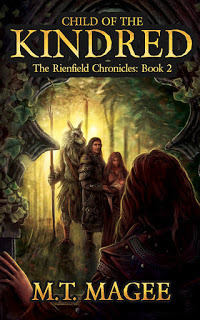 The award winning, epic, historical fantasy, saga continues, with book #2 Child of the Kindred. Enter the realm of Rinefield, where love, danger, adventure and romance awaits you.
The award winning, epic, historical fantasy, saga continues, with book #2 Child of the Kindred. Enter the realm of Rinefield, where love, danger, adventure and romance awaits you. Imagine, the setting a once peaceful beautiful city, in the time of around the 12th century. A fantastical realm evocative of Ireland or Scotland in the middle ages. For the last forty-eight hours your beloved city, known as Gwenlais, has been captured by a madman, and ransacked and plundered by bloody thirsty mercenaries and criminals. Your King dead, and your beloved Princess, held captive, her life constantly threatened. You live in the ransacked city with your family, perhaps you are one of the merchants whose shop or stall has been burned down by the mercenaries. You have seen friends maybe even family killed or injured.
Your hope now lies in an enraged and furious warrior Prince, the husband of your Princess. He brings with him, the vast army of his father’s kingdom, who are prepared at any cost, to free the beloved of their Commander and ruler. You wait quietly in your back rooms, holding your loved ones close. Knowing as the cold grey light of dawn approaches, the army will advance upon your city. All you think of and pray for is, will we survive? And if we do, will our city, our kingdom, survive? Will new life rise from the ruins and misery?
Excerpt from Child of the Kindred Chapter Entitled The Rescue:

“Wake up, you worthless buggers, wake up!” the mercenary called out to the others on the wall. “What is that noise? Why would the savages be playing music?” he asked in a quieter voice, tinged with fear as they all began to stir and move towards the front of the wall.
Several of them looked over warily, the mist still present but starting to thin. At first, they could not quite make out what they were seeing, but within moments, the eyes of the men on the wall filled with fear. In front of them, shapes appeared almost like apparitions, marching forward and holding strange instruments, which made haunting sounds as if wailing in mourning. They were closely followed by figures with drums, strapped to their chests, beating out a rhythm that seemed to beat in time with their own hearts, feeling as if it would crush them. Then without warning as they appeared almost noiselessly, a vast number of horsemen began to ride forward, their faces hidden in the hoods of their cloaks, making it even more surreal and terrifying. The number of riders seemed without end as they continued to ride forward, at a steady but unhurried gait, nearing ever closer to the wall. The dreamlike scene continued to unfold in front of them. The mercenaries stood transfixed, many of them now moving even closer, becoming morbidly fascinated.
Suddenly, a lone tall hooded figure, walked his horse in front of the vast company, coming from in front of the wall, holding up his hand. It fell instantly silent, only the nickering of horses, their hooves anxiously pawing the ground, could be heard. The tall figure then began to speak in a loud, clear voice, the language that could not be understood by the mercenaries, as the words seemed to flow together and follow a distinct rhythm.
“Brothers! Today we take back, what was taken from us! Today the swine that have taken the lives of those we hold dear will have their lives taken from them. Today they will feel the wrath of Heathwin! Savages! Barbarians! Beasts, they call us. They have yet to see why we are called thus. They would dare mock us, threaten the life of our Treasure, your Princess, holding her on the wall, like a meagre trinket, to toy with us? Are we mere dogs, to be cowed and subdued, by using my beloved, your future Queen, as a prize, they threaten to withhold from us?!” the tall figure shouted out to the crowd in front of him. They answered in a single voice, that shook the very air, “Aon!”
The figure then turned and looked up on the wall, staring for an endless moment, as he watched the men on the wall gathering and becoming more bewildered and frantic, as some of them began to cry out, bemoaning their fate.
“Then let it begin. Victory be ours!” the lone figured shouted out, as he unsheathed his sword, raising it high, again the voices joining him as one.
“ Bua a linne! Bua a linne! Bua a linne!” the voices cried out in unison, followed by the pounding of the drums, and swords hitting shields in time, the terrifying battle cry being echoed throughout the city, drifting up to the castle. Those that could hear the cries from inside of their homes moved to back rooms, huddled together, comforting their children, telling them soon it would be over. The Guards that had mingled together in the group of mercenaries, that were throughout the city, began to separate from amongst the ruffians. Walking in the still dark corners of the seemingly sleeping city, to meet in the designated place until it was time to fight back.
Their world is changing, and a new era has begun. Princess Laurel finds her kingdom of Gwenlais, torn and shattered from a bloody siege. Her people now looking to her to help them rise above the ruin and misery inflicted upon their once peaceful and sheltered realm. Laurel, and her beloved Prince Caleb, must find a way to unite their kingdoms as never before. The enemy from a distant land makes a bold and savage attempt to thwart the unity of the two kingdoms of Gwenlais and Heathwin. The odds have never been greater against the realms, or the two lovers that hold the kingdoms together. Will their people and their love survive all they have lost? Will new life rise from above the ruins?
M.T. Magee
 My name is M.T.Magee I write bestselling YA Historical Medieval Fantasy that is beautifully romantic with whispers of Gaelic legend. On Mar. 31st The Treasure of Gwenlais received the 2015 Silver Medal Winner of Ireland's Drunken Druid Award Finalist for IAN Book of the Year Award 2016 for First Novel on Aug. 31st. On Sept.1st 2016 I received the Finalist Award for Readers' Favorite Book Awards Voted #1 On Listopia's Best Fantasy Romance (not urban).
My name is M.T.Magee I write bestselling YA Historical Medieval Fantasy that is beautifully romantic with whispers of Gaelic legend. On Mar. 31st The Treasure of Gwenlais received the 2015 Silver Medal Winner of Ireland's Drunken Druid Award Finalist for IAN Book of the Year Award 2016 for First Novel on Aug. 31st. On Sept.1st 2016 I received the Finalist Award for Readers' Favorite Book Awards Voted #1 On Listopia's Best Fantasy Romance (not urban).I live in New England on our small farm with my husband and son. We raise an assortment of silly goats, quiet rabbits, far too many ducks and chickens, and a high strung Border Collie cross named Gronk.
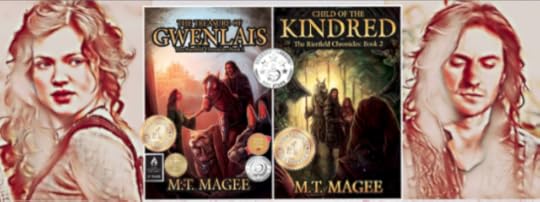
Escape to the award winning mystical realm of Rinefield! Can a young reluctant Princess fulfill her destiny to heal the torn Kingdoms and the heart of a battle hardened warrior Prince? Join Laurel on an extraordinary journey, filled with excitement, treachery, danger and finding a love you only dared dream of! A love story that will leave you breathless, and a world like none imagined! An unforgettable fantasy saga with characters you will fall in love with!
Amazon US Amazon UK
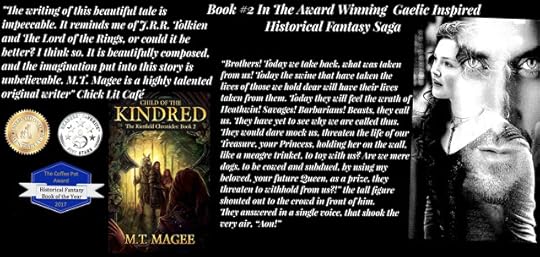
Published on February 22, 2018 23:00
February 21, 2018
Medieval Book Curses By Catherine T Wilson #Medieval #History @LionsandLilies1 @LionsandLilies2
Medieval Book Curses By Catherine T WilsonLife in a medieval society could be both simple and contrary. As quoted by author Barbara Tuchman1 ‘any statement of fact about the Middle Ages may (and probably will) be met by a statement of the opposite or a different version.’ We know their lifestyle was based upon an explicit hierarchy and failure to comply could result in serious consequences. There was feudal law, civil law and when that failed to keep order, religious law often intervened to overrule or frighten a subject into compliance for the church could hold your very soul to ransom. When practical measures failed, fear of damnation could hold sway and this gave the monks who laboured long hours in the scriptoriums a unique way to protect their work from thieves.
 Fig 1. Monks in scriptorium – Photo by Cathy T © - Mont St Michel
Fig 1. Monks in scriptorium – Photo by Cathy T © - Mont St MichelThe law of copyright would not exist until the 18th century. In order to protect their precious books from thieves, religious houses used a practical method of chaining their volumes to fixtures. If you are a Game of Thrones fan, you will have recently seen Sam Tarly working around the chained books in the Citadel’s library in Oldtown. This was not merely fiction – an example of such a library exists at Hereford in the UK.
 Fig. 2. Chained Library at Hereford - Christopher Furlong/Gerry Images Europe
Fig. 2. Chained Library at Hereford - Christopher Furlong/Gerry Images Europe 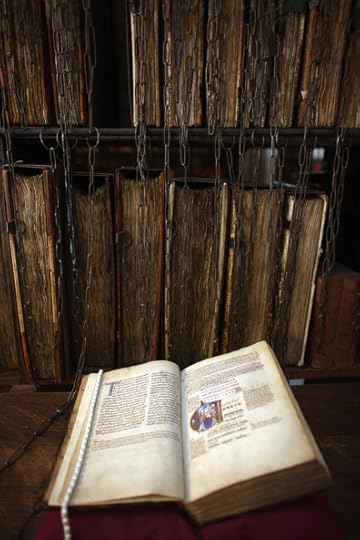 Fig. 3. Chained Library at Hereford - Christopher Furlong/Gerry Images Europe
Fig. 3. Chained Library at Hereford - Christopher Furlong/Gerry Images Europe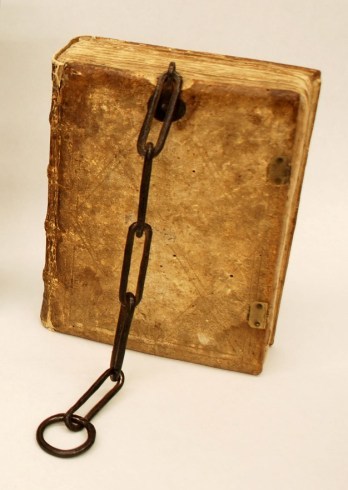
Fig 4 –
 Fig 5. Sam Tarly in the Oldtown Library)
Fig 5. Sam Tarly in the Oldtown Library) If chaining books wasn’t enough to deter would-be thieves then there was one other path open to them – the insertion of a curse, usually on the first page or as part of the colophon, there to forever reside within the volume like a sentinelled demon. If punishment to the body via common law wasn’t enough to dissuade a criminal, perhaps the idea of chastisement to the eternal soul could.
Book and parchment curses date back to ancient times, one of the earliest coming from a 7th century Assyrian king who placed them on his clay tablets which were discovered in 1849 in a library at Ninevah.2One of these curses states:‘He who breaks this tablet or puts it in water or rubs it until you cannot recognise it [and] cannot make it to be understood, may Ashur, Sin, Shamash, Adad and Ishtar, Bel, Nergal, Ishtar of Ninevah, Ishtar of Arbela, Ishtar of Bit Kidmurri, the gods of Heaven and earth and the gods of Assyria, may all these curse him with a curse that cannot be relieved, terrible and merciless, as long as he lives, may they let his name, his seed, be carried off from the land, may they put his flesh in a dog’s mouth.3
Be it in Latin or vernacular, the good brothers of the Middle Ages were not afraid to apply such curses to their parchments either, calling down horrible punishments on miscreants. To steal this book, if you should try,It’s by the throat that you’ll hang high.And ravens then will gather ‘boutTo find your eyes and pull them out.4
In a digitised manuscript at the British Library, a Middle Dutch botanical and bestiary compilation
 Fig. 6
Fig. 6
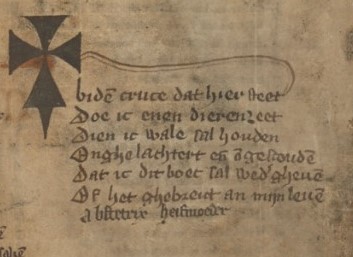 The 14thcentury was filled with such curses calling upon the wrath of God for sinners. In William of Nottingham’s Commentary of the Harmony of the Gospels,6the colophon first praises the scribe and rewards him with a high-quality wine then condemns any offender with death.
The 14thcentury was filled with such curses calling upon the wrath of God for sinners. In William of Nottingham’s Commentary of the Harmony of the Gospels,6the colophon first praises the scribe and rewards him with a high-quality wine then condemns any offender with death. ‘Morteque malorum: raptor libri moriatur.’ (Death from evil things: may the thief of this book die.)
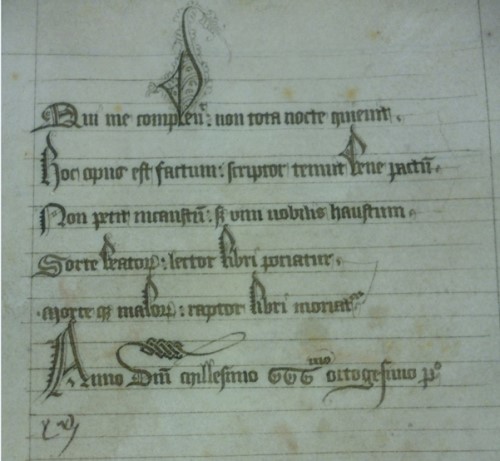 Fig 8 - Other curses call for the perpetrator to be ‘hauled up by the neck.’
Fig 8 - Other curses call for the perpetrator to be ‘hauled up by the neck.’‘Thys boke ys sancht audatys; he þat stelys þe boke shall be haulynth by þe neck.’7
Another from the The Arnstein Bible8 promises to afflict the thief with torture and sickness.
‘Liber sancte Marie sancti que Nycolai in Arrinstein: (The holy books of St Mary and St Nicholas)Quem si quis abstulerit Morte moriatur in sartagine coquatur caducus morbus instet eum et febres · et rotatur et suspendatur Amen
Which translates along the lines of ‘whomsoever shall steal it or take it away, let him be roasted in a frying pan, may the falling sickness (epilepsy) and fever attack him. May he be rotated (on a breaking wheel) and hanged. Amen.’And a curse from a monastery in Rochester for anyone who dares to steal the Book of Distinctiones9will mean his own name shall be deleted from the Book of Life, a tome in which the names of those to be saved at the Last Judgement are recorded. That is definitely a one-way ticket ‘down’ after death!
And if that wasn’t enough, then there were plenty of illuminations to reinforce the idea of eternal damnation (a very popular medieval concept)
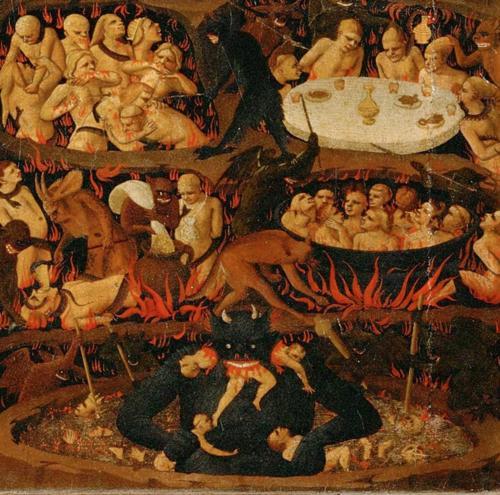 Fig. 11 – Fra Angelico, Last Judgment, 1431-1435, tempera on wood. Museo di San Marco, Florence – the hell side – bottom half)Or this in the Fig 12 - New Minster Liber Vitae, Stowe MS 944, ff.)And last but by no means least, a manuscript11depicting what horrors were waiting – torture, being eaten, hot oil poured onto genitals or boiled alive in a huge cauldron. Take your pick! (Is that book worth all of this later?)
Fig. 11 – Fra Angelico, Last Judgment, 1431-1435, tempera on wood. Museo di San Marco, Florence – the hell side – bottom half)Or this in the Fig 12 - New Minster Liber Vitae, Stowe MS 944, ff.)And last but by no means least, a manuscript11depicting what horrors were waiting – torture, being eaten, hot oil poured onto genitals or boiled alive in a huge cauldron. Take your pick! (Is that book worth all of this later?)
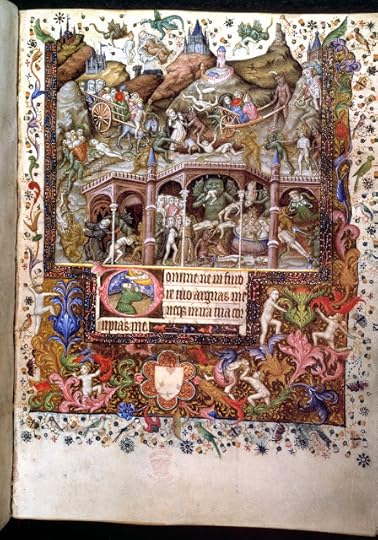 Fig 13 – Hours, chiefly in Latin, containing Calendar. Fr. f. 1. Hours of the Virgin, f. 20. Penitential Psalms and Litany,f 89. ‘Les heures de la …’
Fig 13 – Hours, chiefly in Latin, containing Calendar. Fr. f. 1. Hours of the Virgin, f. 20. Penitential Psalms and Litany,f 89. ‘Les heures de la …’ There are many more depictions, most condemning the perpetrators of crime directly to hell, such was the feeling of abhorrence to thievery of God’s work. I am sure today’s authors might feel the same.Having discovered such a wonderful medieval custom, I could not resist inserting our own curse into The Traitor’s Noose, the fourth book in our Lions and Lilies series. This curse is no kinder than its Middle Age predecessors and the warning comes in the book’s ‘own words.’

From my spine to yours, a word of warning,If you think to harm me, be it night, noon or morning,I feel I should tell you if you have evil intent,That I am protected by a potent enchantment.Terrible things will happen until they cannot be worse,This is the power of a medieval book curse.
When my authors learned of this, like cocks on a midden,They crowed with delight and a curse was hidden,Within these pages, from quill to sword,Double-edged and sharp, to any lady or lord,Who thinks to plunder is honourable – it’s not!So, if you are tempted, I beg you to stop.
Like witches around a cauldron, my authors chanted and weaved,A conjuration so shocking, it’s hard to believe,Such words could pass the lips of these gentile dames,But I swear on my binding, they were not playing games.They called down a plague, a scourge, damnation,Condemnation and castration to ensure ruination.
Should you mark me, or rip me, or steal my contents,You will find yourself in the devil’s presence.This invocation is no jest, it’s proven fact,The 14th Century protected my relatives like that.From my first page to my last and every parchment betwixt,Is steeped in sorcery, on my oath, this is no trick.
My innards are sacred, my humour sublime,But do me an injury and given time,You will begin to notice that all is not well,As you slide down the path which leads straight into Hell.May your eyes fall out and hair, teeth and nailsAs the prettier elements of this incantation prevails.
So, read me and love me, but don’t tamper with my text,Or you will find yourself bewitched by a terrible hex,And it’s not only me but my siblings too,Books One, Two and Three, I tell you true.Lions and Lilies is protected by a divine light,And a tiny curse safeguarding medieval copyright.

Blog by Catherine T Wilson (Co-author of Lions and Lilies series) REFERENCES 1. A Distant Mirror – The Calamitous 14th Century – (forward xvii)2. Norton, Jeremy. "Knowledge as Power: The Earliest Systematically Collected Library as Distinct from an Archive (668 BCE – 627 BCE)". History of Information.3. Libraries in the ancient world. Casson, L. (2001). New Haven: Yale University Press., 2001, pp. 13-144. Anathema – Medieval Scribes and the History of Book Curses - Marc Drogin, Page 78.5. The British Library – digitised manuscripts division (Add MS 11390)6. William of Nottingham’s Commentary on the Harmony of the Gospels, Evesham, c. 1381, Royal MS 4 E II, f. 471r 7. From the church of St Aldate in Gloucester (Add MS 30506) f. 170r 8. The Arnstein Bible - Harley MS 27989. The Book of Life, from the Distinctiones, 13th century, Royal MS 10 A XVI, f. 2r 10. New Minster Liber Vitae, Stowe MS 944 , ff. 6v–7rhttp://blogs.bl.uk/digitisedmanuscripts/2017/10/highway-to-hell.html11. https://www.bl.uk/collection-items/illustration-of-a-scene-in-hell-from-a-book-of-hours
Catherine T Wilson
 ‘My first lasting love? Hmm, I was fourteen when a friend handed me a book about a heroine in France during the 15th Century, and I fell in love with everything medieval. But maybe it didn’t start there. Come to think of it, when I was younger I devoured Alan Garner’s tales of sleeping knights in The Weirdstone of Brisingamen, progressing to King Arthur and Ivanhoe, but somehow that French heroine always stayed with me.’
‘My first lasting love? Hmm, I was fourteen when a friend handed me a book about a heroine in France during the 15th Century, and I fell in love with everything medieval. But maybe it didn’t start there. Come to think of it, when I was younger I devoured Alan Garner’s tales of sleeping knights in The Weirdstone of Brisingamen, progressing to King Arthur and Ivanhoe, but somehow that French heroine always stayed with me.’Catherine was born in Burnley, England, but moved to Australia when she was eleven months old. She grew up in Elizabeth, South Australia, relocating to Queensland when she was fourteen. She worked in communications, before finally deciding to fulfil her dream as a writer. The raw draft of her first novel, a Viking romance, won an encouragement award of $1,000 from six hundred entries, in a popular women’s magazine competition. She visited Europe in 2006 to witness the annual re-enactment of ʻThe Battle of Agincourt,ʼ and then travelled extensively throughout Britain and France, researching material for Lions and Lilies. In 2016, she returned to Europe for further research in Morocco, Spain, Portugal and France. Her visit to Chartres cathedral to ‘walk the labyrinth’ and then stroll through the medieval old town during its summer light show was an experience she’ll never forget. And the second visit to Bellegarde remains among her most treasured memories.Catherine T lives on a small bushland property, on a mountain range west of Brisbane and yes, you need only walk into her house to see her first love. Pictures of maidens on horseback grace the walls, and every corner and mantel is filled with knights and battle axes, the bookshelves overflowing with tales of chivalry.You can contact Catherine on: Website Facebook Twitter Blog
Catherine A Wilson
 ‘My grandmother was a wonderful storyteller and I count myself fortunate to have been able to spend time with her and my great uncles and aunts, who loved nothing more than a good pot of tea with added lashings of gossip. It is their legacy that fuelled my genealogical addiction as I strove to identify fact from fiction and then record the information for posterity. From this sprouted my love of history, the urge to research and write and, eventually, to develop my own stories.‘At the suggestion of Anna Jacobs, another highly successful and talented Australian novelist, I joined Romance Writers Australia. One keystroke error placed me on a chat loop where I met my namesake, Cathy T. After making a crass remark concerning my rather plain name, our friendship was born. We began to regularly email one another, offering words of encouragement (the publishing world is a tough place for the uninitiated – believe me), when Cathy T came upon the idea to create a novel along the lines of our real-time friendship. Hence, Lions and Lilies was born.’
‘My grandmother was a wonderful storyteller and I count myself fortunate to have been able to spend time with her and my great uncles and aunts, who loved nothing more than a good pot of tea with added lashings of gossip. It is their legacy that fuelled my genealogical addiction as I strove to identify fact from fiction and then record the information for posterity. From this sprouted my love of history, the urge to research and write and, eventually, to develop my own stories.‘At the suggestion of Anna Jacobs, another highly successful and talented Australian novelist, I joined Romance Writers Australia. One keystroke error placed me on a chat loop where I met my namesake, Cathy T. After making a crass remark concerning my rather plain name, our friendship was born. We began to regularly email one another, offering words of encouragement (the publishing world is a tough place for the uninitiated – believe me), when Cathy T came upon the idea to create a novel along the lines of our real-time friendship. Hence, Lions and Lilies was born.’Catherine was born in London, England, and immigrated to Australia in 1972 to reside in and around the leafy suburbs of Eastwood, Epping and Dundas. Without a particular path in mind she simply took the first job she was offered, which happened to be the position of Layout Artist for a well-known map publisher, but changed course and selected a career in nursing. She later enlisted in the Royal Australian Air Force, before resigning to a quiet life at home.
She lives in the Blue Mountains, west of Sydney, with her husband and two beautiful children, several Jack Russells, a large flock of flighty chickens, goldfish and budgies. When not writing (which is not often) she likes to garden, read books, shop, read books, drink copious cups of strong coffee with friends and read plenty of books.You can contact Catherine on: Website Facebook Twitter
Lions and Lilies

In the war between England and France a medieval adventure begins with a letter. Two sisters, Cécile and Catherine, enter a world of passion and intrigue, separated as infants, rediscovered by chance. Can they unravel a mystery and be re-united? (The Lily and the Lion – Book One)
A tale of powerful alliances, deadly plots and royal secrets. In an age when women held no power, Cécile and Catherine must rely on the courage of the knights who are assigned to protect them. (The Order of the Lily – Book Two)
A dangerous power play between kingdoms, each must risk their life to foil a plot that could end the reign of one king and send another to war. In the darkest of hours, courage must be found. (The Gilded Crown – Book Three)
What is worse than an unexpected betrayal? Discovering your darkest enemy lies within. When honour demands the ultimate sacrifice – loyalty, trust, love but you know, in the end, justice will be a traitor’s noose. (The Traitor’s Noose – Book Four)
Books are currently available through E-Bay for Australian readers. Second Edition in print and Ebook versions, will be available internationally by February 2018. (Ebook for The Traitor’s Noose is available now via Amazon, Apple and all good Ebook outlets)
*The Authors listings on EBay Australia are dispatched from East Kurrajong, Australia – beware of paying a higher price dispatched from elsewhere!
Published on February 21, 2018 23:00
February 20, 2018
Author’s Inspiration ~ Erika M Szabo #amreading #fantasy @MultiGenreBooks
Please give a warm Coffee Pot welcome to fantasy author, Erika M Szabo.
Author’s Inspiration

Writers can get inspiration anywhere, and any time.
The idea to write this novella came to me when I found an old letter from grandma in my drawer where I keep precious holiday cards and letters. I saved that yellowed letter because I loved her neat handwriting.
It doesn't take much to trigger a writer's imagination, so I started thinking. What if... what if this letter was written by and ancestor who lived hundreds of years ago? What if it would contain information that could save someone in the present? From that moment, the story started to form in my mind.
I imagined Emily as a med student who is planning to spend the summer in Hungary with her brother who is an archeologist. On the flight she meets a man who turns out to be her puppy love from long time ago.
Jayden finds a leather book in his grandmother's secret room that was written in 426 by a shaman. Emily can read the ancient runes, and they learn about their family's curse. If it remains unbroken, the curse will bring tragedy and ruin their lives as it destroyed many of their ancestors' lives for centuries.
Can they find the way to break the curse? Could Emily find happiness with her long-lost friend?
When I had the rough outline of the story, the words started to pour, and I added a lot more secrets, historical facts and legends as well as suspenseful moments to keep the readers at the edge of their seats.
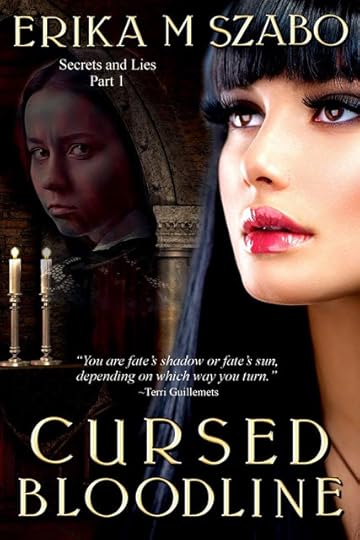
Available in eBook in many online stores
Books2Read
I included the ancient Hun writing in the book, called Rovasiras, which is still used in Hungary, and I imagined what the Shaman’s book would look like.
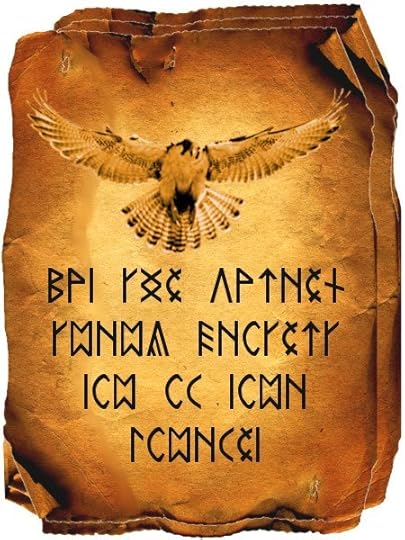
A short excerpt from the book:
They chose a secluded corner table and ordered coffee and pastries.
“It was weird, you know,” Jay began. “When I saw this woman, I could swear it was you. She had the same wavy dark hair and it was even parted on the left, just like yours. She was a mirror image of you, her face, body shape, and everything. The only difference was that she had this crazed look about her that I can’t explain… It was like she was mad at me or something.”
“That is odd.” Emily paused a moment to wonder about what he’d said. “But they say everyone has a twin somewhere in the world.” She tried to justify their unexplainable meeting and hush the dark thoughts that started forming in her mind.
“She disappeared so fast that I couldn’t take a closer look, but she really seemed like a spitting image of you. Weird, and I have no idea what she was doing there. I haven’t seen her before or ever since.”
“What was she wearing?”
“I dunno, like clothes,” Jayden replied with a confused look on his face.
Emily huffed, “You’re such a typical man. Be more specific.”
Jayden tried hard to remember. “I think it was a light-colored shirt and long skirt with maybe flowers or something. Yes, it was like those gypsy girls when they dress up to dance at festivals. I called out and ran after her, but she was gone as if the earth swallowed her. I couldn’t find her anywhere.”
“Well, maybe Aunty Julia knows her. We’ll ask when we get home,” Emily speculated.
“Yeah, she knows everyone in town.” Jayden laughed and then turned serious.
“So, what’s with Daniel? Are you meeting him for dinner?”
“Yes. Can you believe it? He transferred to medical school to New York because he found out I’m going there too. I thought about him a lot and I missed him when we stopped vacationing at Grandma’s.”
“I guess he missed you too, a lot.”
Jayden’s phone rang, and Emily rolled her eyes. “Really? Must you have those chipmunk mating sounds as a ringtone?”
Jayden gave her an apologetic smile and answered his phone. He started a conversation with a college about an artifact, which didn’t really interest Emily.While sipping her coffee, Emily thought about Jayden’s meeting with the strange woman. It made her remember the dark times when she was twelve, and Jayden was fourteen years old.

My baby brother, Aiden... she thought. Her mother’s scream woke them up, and the entire family rushed into the nursery. Before her father could grab Emily and Jayden to rush them out of the room, Emily saw her mom holding the tiny baby’s limp body. Amelia, her twin sister, was standing by the crib. Emily remembered the strange expression and cold smile on her face as she was singing, “Baby don’t cry no more.”
A chill washed through Emily’s body every time she thought about that early morning. Her father rushed them over to the neighbor’s house. They didn’t know what was going on and their parents gave them the sad news that baby Aiden went to Heaven. Jayden and Emily didn’t understand what had happened and they were further confused by the reactions of the adults around them.

When Jayden finished the phone call, he noticed Emily’s sad expression. “What’s wrong Ems?” he asked.
“Do you remember when mom told us that Amelia was very sick and they had to leave her in the hospital? We never saw Amelia after that morning.”
“Yes, we kept asking for a long while when she was coming home, but they gave us the same answer over and over— ‘She’s too sick, and the doctors don’t allow visitors.’ It was a sad time in our lives. What made you think about it?”“Laughter and happiness became scarce in our family after that,” Emily remembered. “Mom and dad were sad all the time, and it reflected on us too. Jay, what if… okay, it’s a crazy thought, but what if Amelia…”
“You’re right, it’s crazy thought. Don’t you remember? For about a year, they visited Amelia in the hospital twice a week and refused to take us with them. They said seeing healthy kids would upset Amelia too much and it would be a constant reminder of what she was missing because she was so sick. But when she passed away, we went to the funeral.”
“The casket was closed,” Emily replied, taking a deep breath. “What if…?” She gasped when a thought occurred to her. “What if she didn’t die and was sent to live in Hungary? It’s possible, isn’t it? Could it be that you saw her?”
“Well, I don’t know… maybe… We never found out how Aiden died and what happened to Amelia. Mom and dad refused to talk about it, and eventually, we stopped asking. That tragic day remains a mystery and a family secret. I never told you, but I tried to find something in newspaper archives, but the only article I’ve found was Aiden’s obituary and it only said that he died of Sudden Infant Death Syndrome.”
“Why didn’t they tell us anything? Why is it such a big secret? I asked grandma too when she visited us, but she refused to say anything.”
“Maybe Aunt Julia knows something.”
“Yes, maybe.”
Jayden started fidgeting, “Are you done? I’m itchy to get home.”
“Yes, let’s get going.” Emily stood up. “I’m not surprised you’re itchy,” she said with a laugh. “You look like a homeless man who hasn’t seen a shower for weeks.”
“I know,” Jayden giggled. “Sorry about offending your sensitive nose, but I was so absorbed in the work at the dig that I forgot about time and didn’t have time to shower and change. I had to rush and speed a little to be on time at the airport.”
“It’s okay, I still love ya.” Emily hugged her brother holding her breath.
They paid the bill and when they got back in the car, Emily took the book out of the duffel bag and started reading.

Altona and Zala rode back to the cave in silence, and they led the horses inside. Altona collapsed to her knees on the sandy floor, and uncontrollable sobs erupted from her chest. “How could they do this? They attack a peaceful village, kill most of the people, and they take everything. What kind of monsters are they? Why didn’t the chief leave some hunters to protect the village?” She looked up at Zala for answers as tears rolled down her face.
“They are the scum of humanity,” Zala whispered. He knelt beside Altona and hugged her to his chest. “We can’t do anything now, and we must wait until sundown.” He gently stroked Altona’s shoulder. “We will take revenge! You are an amazingly accurate archer, and… I’m not so bad myself, thanks to your lessons.”
“We have to go!” Altona tried to squirm out of his embrace. “We have to know what happened to my mother. Maybe we can help them.”
Altona, we can’t help now, but we can find out what is happening. I have a plan. I never told you about my ability…”
Altona pushed Zala away with hope shining in her eyes. “What is your plan, and what is your ability?” she urged.
“The horde will not leave the village until they gorge themselves and rest. Therefore, we have the entire night. We will become their worst nightmare and hunt them from the shadows until the last one of them is dead.” The determined look in his eyes depicted a warrior instead of the gentle Shaman apprentice that he was.
Altona raised her voice, getting impatient. “Zala, what is your ability, and why did you keep it a secret?”
“It will come as a shock. And I didn’t tell you because it is forbidden to reveal the secrets of the Shamans.” Zala bowed his head and continued, “But now that I have very little hope that the Shaman is still alive, I will show you. Keep an open mind, though, and don’t get scared.”
“What is it, Zala? Tell me already!” Altona commanded.
“Okay,” a heavy sigh escaped Zala’s chest, “but I… I’m afraid you will not look at me the same way ever again. I’m afraid you will be afraid of me and you won’t want to be my friend.”
Altona shook her head sadly. “Zala if you think that, then you don’t know me at all. You will always be my friend, no matter what happens, even if you turn into a wolf or something.” She cracked a tiny smile.
“About that…” Zala looked away.
“What? Do I have to beat it out of you?”
“Okay,” Zala decided. “Here it goes. The bloodline I was born into has the ability to connect with the minds of animals. We can see what they see, and we can feel what they feel.”
“No way! Really?” Altona’s eyes sparkled with excitement. “How come you never told me about this?”
Zala sighed and continued, “The Shaman saved me and adopted me when I lived only three seasons. My family and my clan members were butchered by nomad hordes, just like the one that attacked our village. The Shaman wandered for a long time before he found your village. Your clan’s Shaman and his apprentice were mauled and killed by mountain lions when they were meditating deep in the woods, and your clan accepted him as their Shaman. So, now you know, I’m a Link between the human and animal world.” He glanced at Altona with worry in his eyes.
“That’s… I admit it’s unexpected if it’s true. Prove it!”
“I will summon my hawk friend, and through her eyes, I will see what is happening in the village…” He choked up.
Altona turned to Zala. “The hunters were due back by sundown. Maybe they’re back already and took revenge. My mother… and maybe my father and brother…” She sobbed as the possibilities ran through her mind.
“If they hurt them, we will take revenge. Luckily, we have enough arrows stored in the cave. Are you sure you’re ready? You have never killed anyone before. Can you do it?”
Altona leaned forward with a determined look. “Yes, I can. I never told you this, but I did kill a man.”
“How? When?”
“My father took me to visit my uncle’s family not long ago. They live on the other side of the mountain.”
“Yes, I remember that.”
My father forbade me to tell anyone, that’s why I didn’t tell you, but we were attacked by two men close to his brother’s village. We were talking, and we didn’t pay as much attention to the surroundings as we should have. The men jumped out of the bushes and pulled both of us off the horses. One man threw me on the ground and he had that look in his eyes that my mother had warned me about many times.”
Zala’s chest was heaving as he leaned forward, “Did they…,” he asked.
Erika M Szabo
 I became an avid reader at a very early age, thanks to my dad who introduced me to many great books. I write alternate history, romantic fantasy, magical realism novels as well as fun, educational, and bilingual books for children ages 4-12 about acceptance, friendship, family, and moral values such as accepting people with disabilities, dealing with bullies, and not judging others before getting to know them. I also like to encourage children to use their imagination and daydream about fantasy worlds.
I became an avid reader at a very early age, thanks to my dad who introduced me to many great books. I write alternate history, romantic fantasy, magical realism novels as well as fun, educational, and bilingual books for children ages 4-12 about acceptance, friendship, family, and moral values such as accepting people with disabilities, dealing with bullies, and not judging others before getting to know them. I also like to encourage children to use their imagination and daydream about fantasy worlds. Find me on: Website Blog Facebook Twitter

Published on February 20, 2018 23:00
February 19, 2018
Life in Eleventh Century Britain: The Fyrd and the Housecarls By Mercedes Rochelle #History #AngloSaxon @authorrochelle
Life in Eleventh Century Britain:The Fyrd and the Housecarls
By Mercedes Rochelle
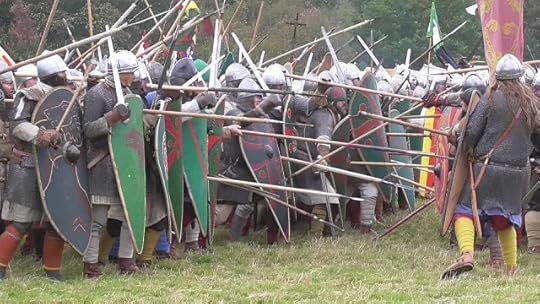
Before the Normans brought over their own version of feudalism, the Anglo-Saxons had a different way of calling up an army in need of defense. At the top of the scale were the Housecarls, the closest thing to a paid, standing army (or household troops) the leader could summon. They were loyal to their employer—the king or a great earl—and were usually composed of Danish or English professional soldiers. Some were landowners; it's possible that some lived in barracks. When King Harold Godwineson unexpectedly had to go north to stop Harold Hardrada in September 1066, the Housecarls were the only warriors he could initially call upon.
Patterned after the Jomsvikings of Denmark (founded by King Harold, father of Swein Forkbeard), Housecarls are first mentioned in relation to King Canute—probably in 1018—and ceased to exist as an organization after the Battle of Hastings. It is believed they were in essence a military guild, with a body of regulations and the ability to call up a gemot or huskarlesteffnein the king’s presence to settle disputes or punish a transgressor.
Highly trained warriors, the Housecarls mostly fought on foot although it is more than possible that they were perfectly capable of fighting on horseback. Snorri Sturluson tells us in Heimskringla that Harold’s mounted troops attacked the disorganized Norwegians in the early phase of the Stamfordbridge battle. They would not have attacked head-on like we picture in the 14th century battles; rather they would veer past the enemy and launch javelins into their foes’ ranks, much like the Normans did at Hastings. Then they would dismount and finish the battle on foot. During the Battle of Hastings, Harold most likely spread out his Housecarls along the shield wall to support the less experienced fyrd; they were the only warriors that returned with him after Stamfordbridge, and by then their ranks had been sorely thinned. The Housecarls would have been a formidable sight; as seen in the Bayeux Tapestry, they could take down both rider and horse with one sweep of their awesome Danish axe. It was a testament to their—and the Anglo Saxon—valor that it took a whole day for William’s well-armed force to break their ranks.
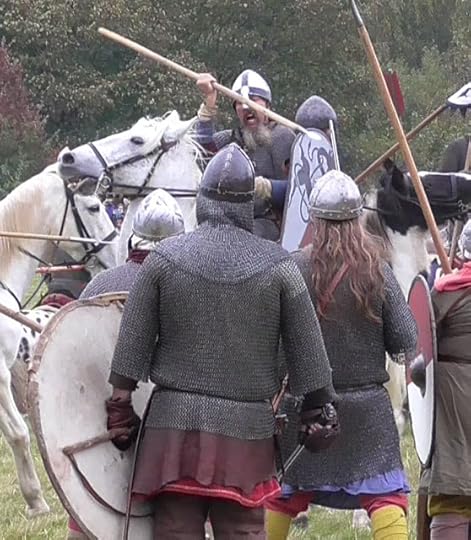
Beneath the Housecarls, the fyrd was drawn from the general population of England. They responded to territorial obligations and were roughly divided into two categories, sometimes known as the select fyrd and the great fyrd. The select fyrd were usually better trained, and were generally composed of thegns, ceorls or upper peasantry. They were assigned on the basis of the 5-hide system throughout southern England (in the Danelaw, the land was assessed in carucates, but the same system is thought to be utilized). By the late Anglo-Saxon period, the hide was not a geographic unit of measure; in essence it was used to determine the amount of service owed to the king. I would theorize it had more to do with a density of population rather than its original definition (equivalent to the amount of land required to feed a peasant family). One lord's manor could contain several 5-hide units, or perhaps several small estates would be stitched together to create one 5-hide unit. The bigger towns had the most hides even though they covered a small area. So for instance Cambridge was assessed at 100 hides; so was Colchester and Shrewsbury. Each would be obliged to produce 20 warriors.
The responsibility of the 5-hide unit was three-fold: military service, fortress work, and bridge repair. For their military obligation, each unit was required to produce one soldier and pay him for two months’ service (20 shillings) if called up by the king. This soldier was usually the same person whenever called up, so this is why he would probably be better trained and equipped than the ordinary fyrdman. Nonetheless, there was no annual training period for the select fyrd, and they were only called up in time of war; years could go by without going into service.
The most important distinction between the two categories of fyrd was that the select fyrd was expected to travel and serve for up to two months. The great fyrd, on the other hand, was called up for strictly local defense. The key difference is that the great fyrd must be able to return home at night; if the king required them to travel, he must pay them a wage. Because they were normally unpaid, they were not expected to come armed with much more than whatever came to hand: clubs, stones tied to sticks, farm utensils, etc. In many cases, they could very well supplement the better-armed select fyrd, which is perhaps what we saw at Hastings.
When taken as a whole, this system seems to have been very well organized. But it did not survive the Norman Conquest. Not all historians are in agreement about this distant era, and I used “Anglo-Saxon Military Instititions” by C.Warren Hollister as my primary source.
Mercedes Rochelle
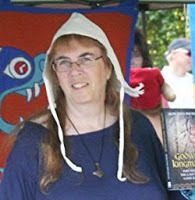 Born in St. Louis MO with a degree from University of Missouri, Mercedes Rochelle learned about living history as a re-enactor and has been enamored with historical fiction ever since. A move to New York to do research and two careers ensued, but writing fiction remains her primary vocation. She lives in Sergeantsville, NJ with her husband in a log home they had built themselves.
Born in St. Louis MO with a degree from University of Missouri, Mercedes Rochelle learned about living history as a re-enactor and has been enamored with historical fiction ever since. A move to New York to do research and two careers ensued, but writing fiction remains her primary vocation. She lives in Sergeantsville, NJ with her husband in a log home they had built themselves.Mercedes loves to hear from readers. You can find her… Website Blog Facebook Twitter
Read more about the end of the Anglo-Saxon era:
Fatal Rivalry
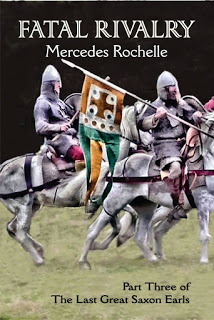 In 1066, the rivalry between two brothers brought England to its knees. WhenDuke William of Normandy landed at Pevensey on September 28, 1066, no onewas there to resist him. King Harold Godwineson was in the north, fightinghis brother Tostig and a fierce Viking invasion. How could this havehappened? Why would Tostig turn traitor to wreak revenge on his brother?The Sons of Godwine were not always enemies. It took a massive Northumbrianuprising to tear them apart, making Tostig an exile and Harold his swornenemy. And when 1066 came to an end, all the Godwinesons were dead exceptone: Wulfnoth, hostage in Normandy. For two generations, Godwine and hissons were a mighty force, but their power faded away as the Anglo-Saxon eracame to a close.
In 1066, the rivalry between two brothers brought England to its knees. WhenDuke William of Normandy landed at Pevensey on September 28, 1066, no onewas there to resist him. King Harold Godwineson was in the north, fightinghis brother Tostig and a fierce Viking invasion. How could this havehappened? Why would Tostig turn traitor to wreak revenge on his brother?The Sons of Godwine were not always enemies. It took a massive Northumbrianuprising to tear them apart, making Tostig an exile and Harold his swornenemy. And when 1066 came to an end, all the Godwinesons were dead exceptone: Wulfnoth, hostage in Normandy. For two generations, Godwine and hissons were a mighty force, but their power faded away as the Anglo-Saxon eracame to a close.Amazon US Amazon UK
Published on February 19, 2018 23:00
February 18, 2018
Life in a fourteenth-century town By April Munday #History @AprilMunday
Life in a fourteenth-century townBy April Munday
If the Doctor whisked you off in his Tardis to a town in the second half of fourteenth-century England, what would you notice?The first thing might be the noise, or the lack of it. You might hear dogs barking, people talking, birds singing and church bells marking the liturgical hours of the day. You would not hear cars, or planes, or engines of any kind. You’ll even be able to hear birds singing.Since the Doctor has brought you to a town on the south coast, you will see that it’s encircled by a strong, stone wall. England and France have been at war since 1337 and the French have attacked and burned towns along the coast, including this one. It’s important to protect the town from them.There are gates at various points along the wall. If you’re in the town for long enough you’ll see that the gates are closed at sunset and aren’t opened again until sunrise. No one is allowed in or out during that time.If you go into a building you’ll notice that the walls are painted or, in wealthier homes, covered in tapestries. Wall are usually painted white first and then painted over with symbols and patterns. The colours will be bright, like the clothes you see around you. Even the parish church is colourful. The statues of the saints are painted, as are the tombs, the walls and the pillars. Since most people still can’t read, the walls of the church are covered in pictures telling stories from the Bible. There’s probably a large doom painting somewhere showing the different fates of those sent to hell and those sent to heaven. There are no chairs in the church. If you come here for mass, you’ll stand.
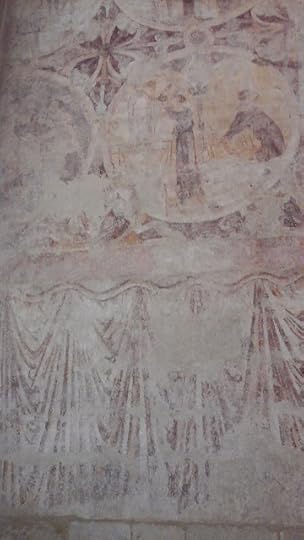 Romsey Abbey
Romsey AbbeyThe streets will mainly be full of people on foot, but you will probably see some people on horseback, women as well as men. Everyone walks or rides. A wealthy sick person might lie on a litter carried by two horses, but no one will be in a carriage. Only the fabulously wealthy can afford them and there are only four or five of them in the whole of England. Most towns have places where itinerant preachers can stand and address the crowds which flock to them. The audience is thrilled to hear about how they can live in a way that pleases God. This is not what they hear from their parish priests and some of them are not sure what to think of their priests, anyway. The priests, and their bishops, failed to give any warning about the Black Death and many of them died along with their parishioners. It seems that God holds them in no higher regard than he does anyone else.If you walk through the town, you’ll see very quickly that it’s small. It won’t take you long to walk from one end to the other, or one side to the other. After the Black Death the population of England is about four and a half million and the vast majority of those do not live in towns. As you go through the town you’ll see the shops. You rarely have to go inside a shop. They’re open-fronted, with the counter facing out into the street. There are also men and women walking the streets selling their wares as they go.
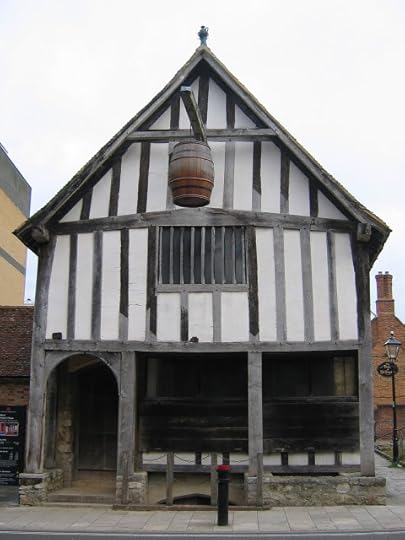 Counter of Medieval Merchant’s House, Southampton.
Counter of Medieval Merchant’s House, Southampton. One thing you will probably notice, even in a busy town, is that people know one another. People live in a community and parishes cover a small geographical area. They go to mass together and to one another’s funerals. People who live next door to one another know exactly what’s going on in the next house. They live very close to one another and will probably stare at you, a stranger, as you pass by.
April Munday
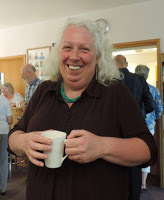 April Munday is the author of romances set in the fourteenth century. She lives in Hampshire, where many of her stories are set. In her head she lives in the fourteenth century, but only in her head; she has learned far too much about life in the Middle Ages to want to live there in reality. She is inspired by the remnants of the past which are part of her local landscape. Her latest series, The Soldiers of Fortune, is set after the Battle of Poitiers, which changes the lives of four brothers.
April Munday is the author of romances set in the fourteenth century. She lives in Hampshire, where many of her stories are set. In her head she lives in the fourteenth century, but only in her head; she has learned far too much about life in the Middle Ages to want to live there in reality. She is inspired by the remnants of the past which are part of her local landscape. Her latest series, The Soldiers of Fortune, is set after the Battle of Poitiers, which changes the lives of four brothers. You can find April over on her blog and on Facebook.
The Heir’s Tale
1357
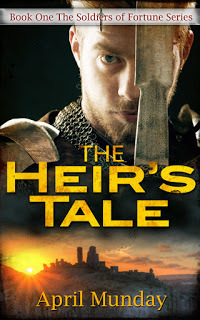 Ancelin Montfort returns to England as his father's heir, following the death of his older brother at the Battle of Poitiers. Everything he does from now on is to prepare him to be the Earl of Somerton, even marrying the woman his father has chosen for him.
Ancelin Montfort returns to England as his father's heir, following the death of his older brother at the Battle of Poitiers. Everything he does from now on is to prepare him to be the Earl of Somerton, even marrying the woman his father has chosen for him.Emma has loved Ancelin through the months of his absence, but the man who has returned from war is not the man who left. As the day of their wedding draws near, she wonders if she ever knew him at all. Then he accuses her of betraying her with another man. Can she convince him of her innocence? Does she want to?Amazon
Published on February 18, 2018 23:00
February 16, 2018
Author’s Inspiration ~ Tom Williams #HistoricalFiction #HistFic @TomCW99
Please give a warm welcome to historical fiction author, Tom Williams.
Author’s Inspiration
 When I was much younger than I am now, I travelled out to Singapore to spend Christmas with my mother-in-law. My mother-in-law was wonderful person in many ways, but could be a bit difficult to spend the whole of the holidays with, so my wife decided that, as a reward, she would take me to spend a few days in Borneo.It was an amazing trip. We stayed in Kuching, the capital of Sarawak, and set off from there to head upriver to spend time in a long house with the indigenous Dyak people. Many of the Dyaks still lived on the most basic slash and burn cultivation and the food they could catch in the jungle. We politely declined eating the monkey that we saw them cooking over an open fire – it looked far too much like a baby as they scraped the fur off to reveal the pink meat below. We caught a tiny mouse deer ourselves and contributed it to the collective pot. It was a magical few days and almost certainly unrepeatable, for the last couple of decades have seen logging destroy much of the habitat the Dyaks rely on to live, while mass tourism means that trips like those we made then are probably by now impossible.
When I was much younger than I am now, I travelled out to Singapore to spend Christmas with my mother-in-law. My mother-in-law was wonderful person in many ways, but could be a bit difficult to spend the whole of the holidays with, so my wife decided that, as a reward, she would take me to spend a few days in Borneo.It was an amazing trip. We stayed in Kuching, the capital of Sarawak, and set off from there to head upriver to spend time in a long house with the indigenous Dyak people. Many of the Dyaks still lived on the most basic slash and burn cultivation and the food they could catch in the jungle. We politely declined eating the monkey that we saw them cooking over an open fire – it looked far too much like a baby as they scraped the fur off to reveal the pink meat below. We caught a tiny mouse deer ourselves and contributed it to the collective pot. It was a magical few days and almost certainly unrepeatable, for the last couple of decades have seen logging destroy much of the habitat the Dyaks rely on to live, while mass tourism means that trips like those we made then are probably by now impossible.
It was on that trip that I first came across James Brooke. The museum in Kuching had an exhibition of Sarawak's history with a large display on 'The White Rajahs' next to a much smaller display on 'The Colonial Era'. I was confused. The White Rajahs were clearly, well, white. Why was it that while the tone of 'The Colonial Era' was rather disapproving (it mainly seems to have consisted of killing the Governor), 'The White Rajahs' display hinted at a Golden Age?
The answer seems to have been the extraordinary relationship the first White Rajah, James Brooke, had with the people of Sarawak. Sarawak then was a province of a much bigger country ruled by Muda Hassim in Brunei. Hassim gave the rule of Sarawak to James Brooke as a reward for Brooke's help suppressing a rebellion there. Brooke insisted that Sarawak was not part of the British Empire and he set out to rule as an enlightened despot.
At the centre of the exhibition was a portrait of James Brooke. It was a copy of the one in London's National Portrait Gallery.
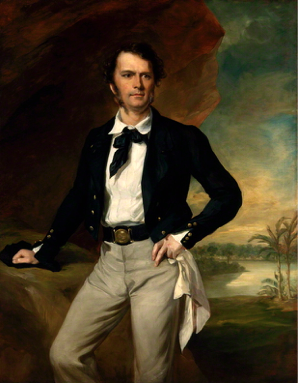
Portrait of Sir James Brooke by Sir Francis Grant
National Portrait Gallery London. Used with permission
I saw it and just wanted to know more about this astonishingly handsome, dashing man who had taken a tiny country halfway round the globe from his home and made it his own. When I got back to England I started to read all I could find about him. It wasn't that difficult. His diaries were published, as were those of Keppel, the admiral who helps him defeat the pirates. I found myself getting more and more caught up in his story and, because I had always wanted to write, I decided to turn it into a novel. What I aimed for was an old-fashioned yarn with an old-fashioned hero and, up to a point, I succeeded. But in the end, although it got representation by a well-known agent, it really wasn't good enough for publication. I put it away and forgot about it.
Years passed and I found myself writing lots of non-fiction, often anonymously. I decided that I owed it to myself to write the novel I've always planned for. We were moving into an age when Western armies were invading remote countries, often with noble intentions but sometimes with terrible consequences. I wanted to write about how good people could end up involved in questionable wars and horrifying massacres. I remembered that James Brooke had himself been involved in a massacre which, at the time, had horrified liberal opinion in Britain and resulted in a Commission of Inquiry in Singapore. I decided to go back to my original novel and rewrite it as a much darker piece with a flawed hero.The result was The White Rajah. Endeavour Press are publishing a new edition of this on 16 February. I hope you enjoy it.
Tom Williams Have you ever noticed how many authors are described as ‘reclusive’? I have a lot of sympathy for them. My feeling is that authors generally like to hide at home with their laptops or their quill pens and write stuff. If they enjoyed being in the public eye, they’d be stand-up comics or pop stars.Nowadays, though, writers are told that their audiences want to be able to relate to them as people. I’m not entirely sure about that. If you knew me, you might not want to relate to me at all. But here in hyperspace I apparently have to tell you that I’m young and good looking and live somewhere exciting with a beautiful partner, a son who is a brain surgeon and a daughter who is a swimwear model. Then you’ll buy my book.Unfortunately, that’s not quite true. I’m older than you can possibly imagine. (Certainly older than I ever imagined until I suddenly woke up and realised that age had snuck up on me.) I live in Richmond, which is nice and on the outskirts of London which is a truly amazing city to live in. My wife is beautiful but, more importantly, she’s a lawyer, which is handy because a household with a writer in it always needs someone who can earn decent money. My son has left home and we never got round to the daughter.We did have a ferret, which I thought would be an appropriately writer sort of thing to have around but he eventually got even older than me (in ferret years) and died. I’d try to say something snappy and amusing about that but we loved that ferret and snappy and amusing doesn’t quite cut it.I street skate and ski and can dance a mean Argentine tango. I’ve spent a lot of my life writing very boring things for money (unless you’re in Customer Care, in which case ‘Dealing With Customer Complaints’ is really, really interesting). Now I’m writing for fun.If you all buy my books, I’ll be able to finish the next ones and I’ll never have to write for the insurance industry again and that will be a good thing, yes? So you’ll not only get to read a brilliant novel but your karmic balance will move rapidly into credit.Can I go back to being reclusive now?Tom loves to hear from readers. You can contact him: Website Facebook Twitter
Have you ever noticed how many authors are described as ‘reclusive’? I have a lot of sympathy for them. My feeling is that authors generally like to hide at home with their laptops or their quill pens and write stuff. If they enjoyed being in the public eye, they’d be stand-up comics or pop stars.Nowadays, though, writers are told that their audiences want to be able to relate to them as people. I’m not entirely sure about that. If you knew me, you might not want to relate to me at all. But here in hyperspace I apparently have to tell you that I’m young and good looking and live somewhere exciting with a beautiful partner, a son who is a brain surgeon and a daughter who is a swimwear model. Then you’ll buy my book.Unfortunately, that’s not quite true. I’m older than you can possibly imagine. (Certainly older than I ever imagined until I suddenly woke up and realised that age had snuck up on me.) I live in Richmond, which is nice and on the outskirts of London which is a truly amazing city to live in. My wife is beautiful but, more importantly, she’s a lawyer, which is handy because a household with a writer in it always needs someone who can earn decent money. My son has left home and we never got round to the daughter.We did have a ferret, which I thought would be an appropriately writer sort of thing to have around but he eventually got even older than me (in ferret years) and died. I’d try to say something snappy and amusing about that but we loved that ferret and snappy and amusing doesn’t quite cut it.I street skate and ski and can dance a mean Argentine tango. I’ve spent a lot of my life writing very boring things for money (unless you’re in Customer Care, in which case ‘Dealing With Customer Complaints’ is really, really interesting). Now I’m writing for fun.If you all buy my books, I’ll be able to finish the next ones and I’ll never have to write for the insurance industry again and that will be a good thing, yes? So you’ll not only get to read a brilliant novel but your karmic balance will move rapidly into credit.Can I go back to being reclusive now?Tom loves to hear from readers. You can contact him: Website Facebook Twitter
Land of SilverWhen charismatic adventurer James Brooke travels to Borneo on the schooner Royalist, he plans to make a great fortune establishing trade between the natives and the British Empire. But even in his flights of fancy, he'd never imagined that he would end up rajah of his own country. The story is told by John Williamson, a young sailor who has travelled with Brooke since he set out from England. They find themselves mixed up in Borneo's civil war, political divisions, and intrigue, being forced further and further away from their dreams and ideals and struggling to establish the British presence on the island - as, meanwhile, love grows between them ... Based on the true story of James Brooke, the first White Rajah of Sarawak, this tale of adventure and love is set against the background of a jungle world of extraordinary beauty and savagery. Amazon US Amazon UK
Author’s Inspiration
 When I was much younger than I am now, I travelled out to Singapore to spend Christmas with my mother-in-law. My mother-in-law was wonderful person in many ways, but could be a bit difficult to spend the whole of the holidays with, so my wife decided that, as a reward, she would take me to spend a few days in Borneo.It was an amazing trip. We stayed in Kuching, the capital of Sarawak, and set off from there to head upriver to spend time in a long house with the indigenous Dyak people. Many of the Dyaks still lived on the most basic slash and burn cultivation and the food they could catch in the jungle. We politely declined eating the monkey that we saw them cooking over an open fire – it looked far too much like a baby as they scraped the fur off to reveal the pink meat below. We caught a tiny mouse deer ourselves and contributed it to the collective pot. It was a magical few days and almost certainly unrepeatable, for the last couple of decades have seen logging destroy much of the habitat the Dyaks rely on to live, while mass tourism means that trips like those we made then are probably by now impossible.
When I was much younger than I am now, I travelled out to Singapore to spend Christmas with my mother-in-law. My mother-in-law was wonderful person in many ways, but could be a bit difficult to spend the whole of the holidays with, so my wife decided that, as a reward, she would take me to spend a few days in Borneo.It was an amazing trip. We stayed in Kuching, the capital of Sarawak, and set off from there to head upriver to spend time in a long house with the indigenous Dyak people. Many of the Dyaks still lived on the most basic slash and burn cultivation and the food they could catch in the jungle. We politely declined eating the monkey that we saw them cooking over an open fire – it looked far too much like a baby as they scraped the fur off to reveal the pink meat below. We caught a tiny mouse deer ourselves and contributed it to the collective pot. It was a magical few days and almost certainly unrepeatable, for the last couple of decades have seen logging destroy much of the habitat the Dyaks rely on to live, while mass tourism means that trips like those we made then are probably by now impossible.It was on that trip that I first came across James Brooke. The museum in Kuching had an exhibition of Sarawak's history with a large display on 'The White Rajahs' next to a much smaller display on 'The Colonial Era'. I was confused. The White Rajahs were clearly, well, white. Why was it that while the tone of 'The Colonial Era' was rather disapproving (it mainly seems to have consisted of killing the Governor), 'The White Rajahs' display hinted at a Golden Age?
The answer seems to have been the extraordinary relationship the first White Rajah, James Brooke, had with the people of Sarawak. Sarawak then was a province of a much bigger country ruled by Muda Hassim in Brunei. Hassim gave the rule of Sarawak to James Brooke as a reward for Brooke's help suppressing a rebellion there. Brooke insisted that Sarawak was not part of the British Empire and he set out to rule as an enlightened despot.
At the centre of the exhibition was a portrait of James Brooke. It was a copy of the one in London's National Portrait Gallery.

Portrait of Sir James Brooke by Sir Francis Grant
National Portrait Gallery London. Used with permission
I saw it and just wanted to know more about this astonishingly handsome, dashing man who had taken a tiny country halfway round the globe from his home and made it his own. When I got back to England I started to read all I could find about him. It wasn't that difficult. His diaries were published, as were those of Keppel, the admiral who helps him defeat the pirates. I found myself getting more and more caught up in his story and, because I had always wanted to write, I decided to turn it into a novel. What I aimed for was an old-fashioned yarn with an old-fashioned hero and, up to a point, I succeeded. But in the end, although it got representation by a well-known agent, it really wasn't good enough for publication. I put it away and forgot about it.
Years passed and I found myself writing lots of non-fiction, often anonymously. I decided that I owed it to myself to write the novel I've always planned for. We were moving into an age when Western armies were invading remote countries, often with noble intentions but sometimes with terrible consequences. I wanted to write about how good people could end up involved in questionable wars and horrifying massacres. I remembered that James Brooke had himself been involved in a massacre which, at the time, had horrified liberal opinion in Britain and resulted in a Commission of Inquiry in Singapore. I decided to go back to my original novel and rewrite it as a much darker piece with a flawed hero.The result was The White Rajah. Endeavour Press are publishing a new edition of this on 16 February. I hope you enjoy it.
Tom Williams
 Have you ever noticed how many authors are described as ‘reclusive’? I have a lot of sympathy for them. My feeling is that authors generally like to hide at home with their laptops or their quill pens and write stuff. If they enjoyed being in the public eye, they’d be stand-up comics or pop stars.Nowadays, though, writers are told that their audiences want to be able to relate to them as people. I’m not entirely sure about that. If you knew me, you might not want to relate to me at all. But here in hyperspace I apparently have to tell you that I’m young and good looking and live somewhere exciting with a beautiful partner, a son who is a brain surgeon and a daughter who is a swimwear model. Then you’ll buy my book.Unfortunately, that’s not quite true. I’m older than you can possibly imagine. (Certainly older than I ever imagined until I suddenly woke up and realised that age had snuck up on me.) I live in Richmond, which is nice and on the outskirts of London which is a truly amazing city to live in. My wife is beautiful but, more importantly, she’s a lawyer, which is handy because a household with a writer in it always needs someone who can earn decent money. My son has left home and we never got round to the daughter.We did have a ferret, which I thought would be an appropriately writer sort of thing to have around but he eventually got even older than me (in ferret years) and died. I’d try to say something snappy and amusing about that but we loved that ferret and snappy and amusing doesn’t quite cut it.I street skate and ski and can dance a mean Argentine tango. I’ve spent a lot of my life writing very boring things for money (unless you’re in Customer Care, in which case ‘Dealing With Customer Complaints’ is really, really interesting). Now I’m writing for fun.If you all buy my books, I’ll be able to finish the next ones and I’ll never have to write for the insurance industry again and that will be a good thing, yes? So you’ll not only get to read a brilliant novel but your karmic balance will move rapidly into credit.Can I go back to being reclusive now?Tom loves to hear from readers. You can contact him: Website Facebook Twitter
Have you ever noticed how many authors are described as ‘reclusive’? I have a lot of sympathy for them. My feeling is that authors generally like to hide at home with their laptops or their quill pens and write stuff. If they enjoyed being in the public eye, they’d be stand-up comics or pop stars.Nowadays, though, writers are told that their audiences want to be able to relate to them as people. I’m not entirely sure about that. If you knew me, you might not want to relate to me at all. But here in hyperspace I apparently have to tell you that I’m young and good looking and live somewhere exciting with a beautiful partner, a son who is a brain surgeon and a daughter who is a swimwear model. Then you’ll buy my book.Unfortunately, that’s not quite true. I’m older than you can possibly imagine. (Certainly older than I ever imagined until I suddenly woke up and realised that age had snuck up on me.) I live in Richmond, which is nice and on the outskirts of London which is a truly amazing city to live in. My wife is beautiful but, more importantly, she’s a lawyer, which is handy because a household with a writer in it always needs someone who can earn decent money. My son has left home and we never got round to the daughter.We did have a ferret, which I thought would be an appropriately writer sort of thing to have around but he eventually got even older than me (in ferret years) and died. I’d try to say something snappy and amusing about that but we loved that ferret and snappy and amusing doesn’t quite cut it.I street skate and ski and can dance a mean Argentine tango. I’ve spent a lot of my life writing very boring things for money (unless you’re in Customer Care, in which case ‘Dealing With Customer Complaints’ is really, really interesting). Now I’m writing for fun.If you all buy my books, I’ll be able to finish the next ones and I’ll never have to write for the insurance industry again and that will be a good thing, yes? So you’ll not only get to read a brilliant novel but your karmic balance will move rapidly into credit.Can I go back to being reclusive now?Tom loves to hear from readers. You can contact him: Website Facebook Twitter Land of SilverWhen charismatic adventurer James Brooke travels to Borneo on the schooner Royalist, he plans to make a great fortune establishing trade between the natives and the British Empire. But even in his flights of fancy, he'd never imagined that he would end up rajah of his own country. The story is told by John Williamson, a young sailor who has travelled with Brooke since he set out from England. They find themselves mixed up in Borneo's civil war, political divisions, and intrigue, being forced further and further away from their dreams and ideals and struggling to establish the British presence on the island - as, meanwhile, love grows between them ... Based on the true story of James Brooke, the first White Rajah of Sarawak, this tale of adventure and love is set against the background of a jungle world of extraordinary beauty and savagery. Amazon US Amazon UK
Published on February 16, 2018 23:00
Author’s Inspiration ~ Tom Williams #HistoricalFiction #HistFic @TomCW9
Please give a warm welcome to historical fiction author, Tom Williams.
Author’s Inspiration
 When I was much younger than I am now, I travelled out to Singapore to spend Christmas with my mother-in-law. My mother-in-law was wonderful person in many ways, but could be a bit difficult to spend the whole of the holidays with, so my wife decided that, as a reward, she would take me to spend a few days in Borneo.It was an amazing trip. We stayed in Kuching, the capital of Sarawak, and set off from there to head upriver to spend time in a long house with the indigenous Dyak people. Many of the Dyaks still lived on the most basic slash and burn cultivation and the food they could catch in the jungle. We politely declined eating the monkey that we saw them cooking over an open fire – it looked far too much like a baby as they scraped the fur off to reveal the pink meat below. We caught a tiny mouse deer ourselves and contributed it to the collective pot. It was a magical few days and almost certainly unrepeatable, for the last couple of decades have seen logging destroy much of the habitat the Dyaks rely on to live, while mass tourism means that trips like those we made then are probably by now impossible.
When I was much younger than I am now, I travelled out to Singapore to spend Christmas with my mother-in-law. My mother-in-law was wonderful person in many ways, but could be a bit difficult to spend the whole of the holidays with, so my wife decided that, as a reward, she would take me to spend a few days in Borneo.It was an amazing trip. We stayed in Kuching, the capital of Sarawak, and set off from there to head upriver to spend time in a long house with the indigenous Dyak people. Many of the Dyaks still lived on the most basic slash and burn cultivation and the food they could catch in the jungle. We politely declined eating the monkey that we saw them cooking over an open fire – it looked far too much like a baby as they scraped the fur off to reveal the pink meat below. We caught a tiny mouse deer ourselves and contributed it to the collective pot. It was a magical few days and almost certainly unrepeatable, for the last couple of decades have seen logging destroy much of the habitat the Dyaks rely on to live, while mass tourism means that trips like those we made then are probably by now impossible.
It was on that trip that I first came across James Brooke. The museum in Kuching had an exhibition of Sarawak's history with a large display on 'The White Rajahs' next to a much smaller display on 'The Colonial Era'. I was confused. The White Rajahs were clearly, well, white. Why was it that while the tone of 'The Colonial Era' was rather disapproving (it mainly seems to have consisted of killing the Governor), 'The White Rajahs' display hinted at a Golden Age?
The answer seems to have been the extraordinary relationship the first White Rajah, James Brooke, had with the people of Sarawak. Sarawak then was a province of a much bigger country ruled by Muda Hassim in Brunei. Hassim gave the rule of Sarawak to James Brooke as a reward for Brooke's help suppressing a rebellion there. Brooke insisted that Sarawak was not part of the British Empire and he set out to rule as an enlightened despot.
At the centre of the exhibition was a portrait of James Brooke. It was a copy of the one in London's National Portrait Gallery.

Portrait of Sir James Brooke by Sir Francis Grant
National Portrait Gallery London. Used with permission
I saw it and just wanted to know more about this astonishingly handsome, dashing man who had taken a tiny country halfway round the globe from his home and made it his own. When I got back to England I started to read all I could find about him. It wasn't that difficult. His diaries were published, as were those of Keppel, the admiral who helps him defeat the pirates. I found myself getting more and more caught up in his story and, because I had always wanted to write, I decided to turn it into a novel. What I aimed for was an old-fashioned yarn with an old-fashioned hero and, up to a point, I succeeded. But in the end, although it got representation by a well-known agent, it really wasn't good enough for publication. I put it away and forgot about it.
Years passed and I found myself writing lots of non-fiction, often anonymously. I decided that I owed it to myself to write the novel I've always planned for. We were moving into an age when Western armies were invading remote countries, often with noble intentions but sometimes with terrible consequences. I wanted to write about how good people could end up involved in questionable wars and horrifying massacres. I remembered that James Brooke had himself been involved in a massacre which, at the time, had horrified liberal opinion in Britain and resulted in a Commission of Inquiry in Singapore. I decided to go back to my original novel and rewrite it as a much darker piece with a flawed hero.The result was The White Rajah. Endeavour Press are publishing a new edition of this on 16 February. I hope you enjoy it.
Tom Williams Have you ever noticed how many authors are described as ‘reclusive’? I have a lot of sympathy for them. My feeling is that authors generally like to hide at home with their laptops or their quill pens and write stuff. If they enjoyed being in the public eye, they’d be stand-up comics or pop stars.Nowadays, though, writers are told that their audiences want to be able to relate to them as people. I’m not entirely sure about that. If you knew me, you might not want to relate to me at all. But here in hyperspace I apparently have to tell you that I’m young and good looking and live somewhere exciting with a beautiful partner, a son who is a brain surgeon and a daughter who is a swimwear model. Then you’ll buy my book.Unfortunately, that’s not quite true. I’m older than you can possibly imagine. (Certainly older than I ever imagined until I suddenly woke up and realised that age had snuck up on me.) I live in Richmond, which is nice and on the outskirts of London which is a truly amazing city to live in. My wife is beautiful but, more importantly, she’s a lawyer, which is handy because a household with a writer in it always needs someone who can earn decent money. My son has left home and we never got round to the daughter.We did have a ferret, which I thought would be an appropriately writer sort of thing to have around but he eventually got even older than me (in ferret years) and died. I’d try to say something snappy and amusing about that but we loved that ferret and snappy and amusing doesn’t quite cut it.I street skate and ski and can dance a mean Argentine tango. I’ve spent a lot of my life writing very boring things for money (unless you’re in Customer Care, in which case ‘Dealing With Customer Complaints’ is really, really interesting). Now I’m writing for fun.If you all buy my books, I’ll be able to finish the next ones and I’ll never have to write for the insurance industry again and that will be a good thing, yes? So you’ll not only get to read a brilliant novel but your karmic balance will move rapidly into credit.Can I go back to being reclusive now?Tom loves to hear from readers. You can contact him: Website Facebook Twitter
Have you ever noticed how many authors are described as ‘reclusive’? I have a lot of sympathy for them. My feeling is that authors generally like to hide at home with their laptops or their quill pens and write stuff. If they enjoyed being in the public eye, they’d be stand-up comics or pop stars.Nowadays, though, writers are told that their audiences want to be able to relate to them as people. I’m not entirely sure about that. If you knew me, you might not want to relate to me at all. But here in hyperspace I apparently have to tell you that I’m young and good looking and live somewhere exciting with a beautiful partner, a son who is a brain surgeon and a daughter who is a swimwear model. Then you’ll buy my book.Unfortunately, that’s not quite true. I’m older than you can possibly imagine. (Certainly older than I ever imagined until I suddenly woke up and realised that age had snuck up on me.) I live in Richmond, which is nice and on the outskirts of London which is a truly amazing city to live in. My wife is beautiful but, more importantly, she’s a lawyer, which is handy because a household with a writer in it always needs someone who can earn decent money. My son has left home and we never got round to the daughter.We did have a ferret, which I thought would be an appropriately writer sort of thing to have around but he eventually got even older than me (in ferret years) and died. I’d try to say something snappy and amusing about that but we loved that ferret and snappy and amusing doesn’t quite cut it.I street skate and ski and can dance a mean Argentine tango. I’ve spent a lot of my life writing very boring things for money (unless you’re in Customer Care, in which case ‘Dealing With Customer Complaints’ is really, really interesting). Now I’m writing for fun.If you all buy my books, I’ll be able to finish the next ones and I’ll never have to write for the insurance industry again and that will be a good thing, yes? So you’ll not only get to read a brilliant novel but your karmic balance will move rapidly into credit.Can I go back to being reclusive now?Tom loves to hear from readers. You can contact him: Website Facebook Twitter
Land of SilverWhen charismatic adventurer James Brooke travels to Borneo on the schooner Royalist, he plans to make a great fortune establishing trade between the natives and the British Empire. But even in his flights of fancy, he'd never imagined that he would end up rajah of his own country. The story is told by John Williamson, a young sailor who has travelled with Brooke since he set out from England. They find themselves mixed up in Borneo's civil war, political divisions, and intrigue, being forced further and further away from their dreams and ideals and struggling to establish the British presence on the island - as, meanwhile, love grows between them ... Based on the true story of James Brooke, the first White Rajah of Sarawak, this tale of adventure and love is set against the background of a jungle world of extraordinary beauty and savagery.
Amazon US Amazon UK
Author’s Inspiration
 When I was much younger than I am now, I travelled out to Singapore to spend Christmas with my mother-in-law. My mother-in-law was wonderful person in many ways, but could be a bit difficult to spend the whole of the holidays with, so my wife decided that, as a reward, she would take me to spend a few days in Borneo.It was an amazing trip. We stayed in Kuching, the capital of Sarawak, and set off from there to head upriver to spend time in a long house with the indigenous Dyak people. Many of the Dyaks still lived on the most basic slash and burn cultivation and the food they could catch in the jungle. We politely declined eating the monkey that we saw them cooking over an open fire – it looked far too much like a baby as they scraped the fur off to reveal the pink meat below. We caught a tiny mouse deer ourselves and contributed it to the collective pot. It was a magical few days and almost certainly unrepeatable, for the last couple of decades have seen logging destroy much of the habitat the Dyaks rely on to live, while mass tourism means that trips like those we made then are probably by now impossible.
When I was much younger than I am now, I travelled out to Singapore to spend Christmas with my mother-in-law. My mother-in-law was wonderful person in many ways, but could be a bit difficult to spend the whole of the holidays with, so my wife decided that, as a reward, she would take me to spend a few days in Borneo.It was an amazing trip. We stayed in Kuching, the capital of Sarawak, and set off from there to head upriver to spend time in a long house with the indigenous Dyak people. Many of the Dyaks still lived on the most basic slash and burn cultivation and the food they could catch in the jungle. We politely declined eating the monkey that we saw them cooking over an open fire – it looked far too much like a baby as they scraped the fur off to reveal the pink meat below. We caught a tiny mouse deer ourselves and contributed it to the collective pot. It was a magical few days and almost certainly unrepeatable, for the last couple of decades have seen logging destroy much of the habitat the Dyaks rely on to live, while mass tourism means that trips like those we made then are probably by now impossible.It was on that trip that I first came across James Brooke. The museum in Kuching had an exhibition of Sarawak's history with a large display on 'The White Rajahs' next to a much smaller display on 'The Colonial Era'. I was confused. The White Rajahs were clearly, well, white. Why was it that while the tone of 'The Colonial Era' was rather disapproving (it mainly seems to have consisted of killing the Governor), 'The White Rajahs' display hinted at a Golden Age?
The answer seems to have been the extraordinary relationship the first White Rajah, James Brooke, had with the people of Sarawak. Sarawak then was a province of a much bigger country ruled by Muda Hassim in Brunei. Hassim gave the rule of Sarawak to James Brooke as a reward for Brooke's help suppressing a rebellion there. Brooke insisted that Sarawak was not part of the British Empire and he set out to rule as an enlightened despot.
At the centre of the exhibition was a portrait of James Brooke. It was a copy of the one in London's National Portrait Gallery.

Portrait of Sir James Brooke by Sir Francis Grant
National Portrait Gallery London. Used with permission
I saw it and just wanted to know more about this astonishingly handsome, dashing man who had taken a tiny country halfway round the globe from his home and made it his own. When I got back to England I started to read all I could find about him. It wasn't that difficult. His diaries were published, as were those of Keppel, the admiral who helps him defeat the pirates. I found myself getting more and more caught up in his story and, because I had always wanted to write, I decided to turn it into a novel. What I aimed for was an old-fashioned yarn with an old-fashioned hero and, up to a point, I succeeded. But in the end, although it got representation by a well-known agent, it really wasn't good enough for publication. I put it away and forgot about it.
Years passed and I found myself writing lots of non-fiction, often anonymously. I decided that I owed it to myself to write the novel I've always planned for. We were moving into an age when Western armies were invading remote countries, often with noble intentions but sometimes with terrible consequences. I wanted to write about how good people could end up involved in questionable wars and horrifying massacres. I remembered that James Brooke had himself been involved in a massacre which, at the time, had horrified liberal opinion in Britain and resulted in a Commission of Inquiry in Singapore. I decided to go back to my original novel and rewrite it as a much darker piece with a flawed hero.The result was The White Rajah. Endeavour Press are publishing a new edition of this on 16 February. I hope you enjoy it.
Tom Williams
 Have you ever noticed how many authors are described as ‘reclusive’? I have a lot of sympathy for them. My feeling is that authors generally like to hide at home with their laptops or their quill pens and write stuff. If they enjoyed being in the public eye, they’d be stand-up comics or pop stars.Nowadays, though, writers are told that their audiences want to be able to relate to them as people. I’m not entirely sure about that. If you knew me, you might not want to relate to me at all. But here in hyperspace I apparently have to tell you that I’m young and good looking and live somewhere exciting with a beautiful partner, a son who is a brain surgeon and a daughter who is a swimwear model. Then you’ll buy my book.Unfortunately, that’s not quite true. I’m older than you can possibly imagine. (Certainly older than I ever imagined until I suddenly woke up and realised that age had snuck up on me.) I live in Richmond, which is nice and on the outskirts of London which is a truly amazing city to live in. My wife is beautiful but, more importantly, she’s a lawyer, which is handy because a household with a writer in it always needs someone who can earn decent money. My son has left home and we never got round to the daughter.We did have a ferret, which I thought would be an appropriately writer sort of thing to have around but he eventually got even older than me (in ferret years) and died. I’d try to say something snappy and amusing about that but we loved that ferret and snappy and amusing doesn’t quite cut it.I street skate and ski and can dance a mean Argentine tango. I’ve spent a lot of my life writing very boring things for money (unless you’re in Customer Care, in which case ‘Dealing With Customer Complaints’ is really, really interesting). Now I’m writing for fun.If you all buy my books, I’ll be able to finish the next ones and I’ll never have to write for the insurance industry again and that will be a good thing, yes? So you’ll not only get to read a brilliant novel but your karmic balance will move rapidly into credit.Can I go back to being reclusive now?Tom loves to hear from readers. You can contact him: Website Facebook Twitter
Have you ever noticed how many authors are described as ‘reclusive’? I have a lot of sympathy for them. My feeling is that authors generally like to hide at home with their laptops or their quill pens and write stuff. If they enjoyed being in the public eye, they’d be stand-up comics or pop stars.Nowadays, though, writers are told that their audiences want to be able to relate to them as people. I’m not entirely sure about that. If you knew me, you might not want to relate to me at all. But here in hyperspace I apparently have to tell you that I’m young and good looking and live somewhere exciting with a beautiful partner, a son who is a brain surgeon and a daughter who is a swimwear model. Then you’ll buy my book.Unfortunately, that’s not quite true. I’m older than you can possibly imagine. (Certainly older than I ever imagined until I suddenly woke up and realised that age had snuck up on me.) I live in Richmond, which is nice and on the outskirts of London which is a truly amazing city to live in. My wife is beautiful but, more importantly, she’s a lawyer, which is handy because a household with a writer in it always needs someone who can earn decent money. My son has left home and we never got round to the daughter.We did have a ferret, which I thought would be an appropriately writer sort of thing to have around but he eventually got even older than me (in ferret years) and died. I’d try to say something snappy and amusing about that but we loved that ferret and snappy and amusing doesn’t quite cut it.I street skate and ski and can dance a mean Argentine tango. I’ve spent a lot of my life writing very boring things for money (unless you’re in Customer Care, in which case ‘Dealing With Customer Complaints’ is really, really interesting). Now I’m writing for fun.If you all buy my books, I’ll be able to finish the next ones and I’ll never have to write for the insurance industry again and that will be a good thing, yes? So you’ll not only get to read a brilliant novel but your karmic balance will move rapidly into credit.Can I go back to being reclusive now?Tom loves to hear from readers. You can contact him: Website Facebook Twitter Land of SilverWhen charismatic adventurer James Brooke travels to Borneo on the schooner Royalist, he plans to make a great fortune establishing trade between the natives and the British Empire. But even in his flights of fancy, he'd never imagined that he would end up rajah of his own country. The story is told by John Williamson, a young sailor who has travelled with Brooke since he set out from England. They find themselves mixed up in Borneo's civil war, political divisions, and intrigue, being forced further and further away from their dreams and ideals and struggling to establish the British presence on the island - as, meanwhile, love grows between them ... Based on the true story of James Brooke, the first White Rajah of Sarawak, this tale of adventure and love is set against the background of a jungle world of extraordinary beauty and savagery.
Amazon US Amazon UK
Published on February 16, 2018 23:00
February 15, 2018
Life in the time of… Richard, Duke of Gloucester and Lord John Elder by Derek Birks #History #Medieval #RichardIII @Feud_writer
Life in the time of… Richard, Duke of Gloucester and Lord John Elder.By Derek Birks
1483 was a year of crisis – possibly one of the most hotly debated crises in history and certainly in late medieval English history.
Why? Because it involved the overthrow and probable death of a boy king, Edward V, and at the same time it propelled onto the pages of history Richard, Duke of Gloucester and later Richard III - a man that everyone seems either to love or loathe!
What makes it so fascinating is the speed with which apparently stable government descended into chaos.
At Easter 1483 all was well in the kingdom of England. The king, Edward IV, was in his forties and had two male heirs to succeed him. In the north he had the support of his trusted brother, Richard Duke of Gloucester, in whom he had vested great power and influence. Elsewhere, several other loyal magnates kept the kingdom at peace: Thomas Stanley in the north-west, the Howards in East Anglia, Lord William Hastings in the Midlands and Anthony Woodville, Earl Rivers in the West. Rivers, the queen’s brother, also acted as the governor of Edward, Prince of Wales at Ludlow.

As I said, all was well - until, after a sudden short illness, King Edward IV died.
With amazing rapidity, chaos ensued as jealousies kept under control by the late king now reared up and threatened to tear the governing classes apart.
Lord Hastings, fearful that the queen’s relatives would wield more power under the new king, 12 year old Edward V, wrote in panic to Richard of Gloucester urging him to come south with all speed. Meanwhile the King’s Council attempted to make plans for Edward’s coronation amid an atmosphere of rumour and suspicion.Then on 29th April 1483, seemingly out of the blue, there was a coup.
Earl Rivers, escorting the young king to London, had arranged to meet the Dukes of Gloucester and Buckingham at Northampton, where we are told they enjoyed a convivial evening. The following morning, however, Rivers and several other officers of the crown, were arrested by Gloucester and Buckingham.
This single act changed the political landscape radically.
So much has been written about the sequence of events that followed the arrest that I shall not attempt to add to it here. The issue which has captured people’s imagination most – almost from 1483 onwards to the present day - is the question of what happened to Edward V and his younger brother – the so-called ‘princes in the tower’.Everyone has a view on this from the ‘man – or woman - on the street’ to the most eminent historians we have.
Spoiler alert! We don’t know the answer and since the evidence to support any explanation is almost non-existent, folk have resorted to other means. The best we can do is try to consider what could have happened and historical fiction is as good a way as any to see how the events of 1483 might have played out.
My new novel, The Blood of Princes , is woven tightly around the historical events of 1483 and some of the actual people closely involved in the events. My story is about the survival of the Elders – a middling baronial family (fictional) - but it is closely entwined with the fate of the princes and Richard, Duke of Gloucester.

The Blood of Princes is the second in a series called The Craft of Kings . It tells the story of how the Elder family, notably the hero, Lord John Elder, become embroiled in the events of 1483.
So who is John Elder and where does he fit into the crisis of 1483?
John is a minor lord who owns ten manors in various parts of the country – typical perhaps of those men of moderate substance who provided the backbone of any medieval local government. He and other members of his family have strong connections with the previous king, Edward IV. [For which, see my Rebels & Brothers series]
In my story, John is assigned to protect young Edward V – having had some dealings with him when he was Prince of Wales in the previous book, Scars from the Past .Since he is with Earl Rivers at the point of his arrest, our protagonist is at the centre of the whole story from the start.
John is a taciturn sort of chap, recently married and still not entirely sure how to live with his father’s rather daunting legend. Thus he brings his own character flaws and anxieties to a situation that has more than enough already.
Through the eyes of John, his relatives and household men and women, we witness the interaction of the real people of the royal court. We feel the tension begin to rise; we wince at the betrayals, and experience the fears and doubts of those in London at a time of very great uncertainty.
And what of those without power, wealth or influence?
I always like to include a raft of characters who inhabit the darker recesses of late medieval society at its lower levels. In this book the focus is on London, so we have an array of town-dwelling common folk: humble archers and men at arms, serving girls and whores. These people also had a part to play in events though they existed in a sort of parallel universe.
Their struggle for survival had more to do with scratching out a living in a brutal world of filth, poverty and crime than worrying about who would be the next king. Most knew their place and their place was at the bottom of the heap. Yet in every important event these people are there; they are involved – required even - if political actions are to have any substance or meaning.
While I have sought to provide an outcome as far as the princes are concerned and have tried to give some context and explanation for the motives of several key political players, this is a work of fiction, not history.
As someone who has studied exhaustively and taught the events of this period over decades, I think I can reasonably claim to know a little about it. Do I believe this is how it might have happened in 1483? Aside from the fictional elements of my story, yes, I do, but I do not claim to be ‘right’ – because no-one can!
Derek Birks
 Derek was born in Hampshire in England but spent his teenage years in Auckland, New Zealand, where he still has strong family ties. On his return to England, after eight years abroad, he read history at Reading University.As long as he can remember, Derek has loved books and he always wanted to write. By the age of 17, he was writing stories, songs, poetry – in fact virtually anything. Inevitably, after university, work and family life took precedence and for many years he taught history in a secondary school. Though he enjoyed teaching immensely, he also found a creative outlet in theatrical activities: stage-managing musicals and outdoor Shakespeare, including a performance of Henry VIII for the Queen’s Silver Jubilee in 1977 at Windsor Castle.In 2010 Derek took early retirement to concentrate on writing. He aims to write action-packed fiction, rooted in accurate history. Though he is interested in everything historical, his particular favourite is the late medieval period. So far he has completed one 4-book series, entitled
Rebels and Brothers
, which is set during the Wars of the Roses and he has now embarked on another Wars of the Roses series:
The Craft of Kings.
The series begins with
Scars from the Past.
‘As with all good historical fiction, the reader learns fascinating period detail while being entertained by an experienced author who knows his trade.’ Historical Novel Society review of
Scars from the Past
Derek was born in Hampshire in England but spent his teenage years in Auckland, New Zealand, where he still has strong family ties. On his return to England, after eight years abroad, he read history at Reading University.As long as he can remember, Derek has loved books and he always wanted to write. By the age of 17, he was writing stories, songs, poetry – in fact virtually anything. Inevitably, after university, work and family life took precedence and for many years he taught history in a secondary school. Though he enjoyed teaching immensely, he also found a creative outlet in theatrical activities: stage-managing musicals and outdoor Shakespeare, including a performance of Henry VIII for the Queen’s Silver Jubilee in 1977 at Windsor Castle.In 2010 Derek took early retirement to concentrate on writing. He aims to write action-packed fiction, rooted in accurate history. Though he is interested in everything historical, his particular favourite is the late medieval period. So far he has completed one 4-book series, entitled
Rebels and Brothers
, which is set during the Wars of the Roses and he has now embarked on another Wars of the Roses series:
The Craft of Kings.
The series begins with
Scars from the Past.
‘As with all good historical fiction, the reader learns fascinating period detail while being entertained by an experienced author who knows his trade.’ Historical Novel Society review of
Scars from the Past
Apart from his writing, he enjoys travelling – often to carry out research for his books - and also spends his time gardening, walking and taking part in archaeological digs. You can find Derek...Twitter Website Blog Facebook Amazon author page
The Blood of Princes
A savage tale of love, treason and betrayal.A bloody struggle for power at the heart of the royal court.
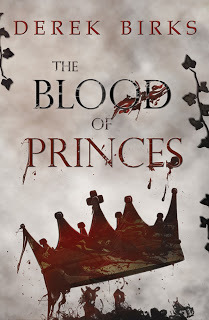 In April 1483, the sudden death of King Edward IV brings his twelve year old son to the throne.Restless young lord and ex-mercenary John Elder is newly-appointed to the service of Edward, Prince of Wales, and charged with the boy’s safety. His first task, escorting the new king to London for his coronation, seems a simple one but the accession of a boy king raises concerns among the leading noblemen of the land. As old jealousies and feuds are rekindled, the new king’s uncle, Richard, Duke of Gloucester, seizes control and plunges the kingdom into crisis. But is Gloucester young Edward’s enemy, or saviour?While John, outlawed and trapped, must wait to see how events unfold, other members of the battle-scarred Elder family are drawn, one by one, into his conspiracy. Soon they are mired so deep in the murky underbelly of London society, that there seems no hope of escape from the tangle of intrigue and murder.In the end, all lives will hang upon the outcome of a daring incursion into the Tower of London itself. <!-- /* Font Definitions */ @font-face {font-family:"Cambria Math"; panose-1:2 4 5 3 5 4 6 3 2 4; mso-font-charset:0; mso-generic-font-family:auto; mso-font-pitch:variable; mso-font-signature:-536870145 1107305727 0 0 415 0;} @font-face {font-family:Calibri; panose-1:2 15 5 2 2 2 4 3 2 4; mso-font-charset:0; mso-generic-font-family:auto; mso-font-pitch:variable; mso-font-signature:-520092929 1073786111 9 0 415 0;} /* Style Definitions */ p.MsoNormal, li.MsoNormal, div.MsoNormal {mso-style-unhide:no; mso-style-qformat:yes; mso-style-parent:""; margin-top:0cm; margin-right:0cm; margin-bottom:10.0pt; margin-left:0cm; line-height:115%; mso-pagination:widow-orphan; font-size:11.0pt; font-family:Calibri; mso-ascii-font-family:Calibri; mso-ascii-theme-font:minor-latin; mso-fareast-font-family:Calibri; mso-fareast-theme-font:minor-latin; mso-hansi-font-family:Calibri; mso-hansi-theme-font:minor-latin; mso-bidi-font-family:"Times New Roman"; mso-bidi-theme-font:minor-bidi;} a:link, span.MsoHyperlink {mso-style-priority:99; mso-style-qformat:yes; color:blue; text-decoration:none; text-underline:none;} a:visited, span.MsoHyperlinkFollowed {mso-style-noshow:yes; mso-style-priority:99; color:purple; mso-themecolor:followedhyperlink; text-decoration:underline; text-underline:single;} .MsoChpDefault {mso-style-type:export-only; mso-default-props:yes; font-size:11.0pt; mso-ansi-font-size:11.0pt; mso-bidi-font-size:11.0pt; font-family:Calibri; mso-ascii-font-family:Calibri; mso-ascii-theme-font:minor-latin; mso-fareast-font-family:Calibri; mso-fareast-theme-font:minor-latin; mso-hansi-font-family:Calibri; mso-hansi-theme-font:minor-latin; mso-bidi-font-family:"Times New Roman"; mso-bidi-theme-font:minor-bidi;} .MsoPapDefault {mso-style-type:export-only; margin-bottom:10.0pt; line-height:115%;} @page WordSection1 {size:612.0pt 792.0pt; margin:72.0pt 90.0pt 72.0pt 90.0pt; mso-header-margin:36.0pt; mso-footer-margin:36.0pt; mso-paper-source:0;} div.WordSection1 {page:WordSection1;} </style></span></div><div align="center" class="MsoNormal" style="text-align: center;"><span style="font-family: "times new roman"; font-size: 28.0pt; line-height: 115%;"><a href="http://amzn.to/2BlAs76">Amazon US<span style="mso-spacerun: yes;"> </span></a><span style="mso-spacerun: yes;"> </span><a href="http://amzn.to/2G6IWTs">Amazon UK</a><o:p></o:p></span></div><br />
In April 1483, the sudden death of King Edward IV brings his twelve year old son to the throne.Restless young lord and ex-mercenary John Elder is newly-appointed to the service of Edward, Prince of Wales, and charged with the boy’s safety. His first task, escorting the new king to London for his coronation, seems a simple one but the accession of a boy king raises concerns among the leading noblemen of the land. As old jealousies and feuds are rekindled, the new king’s uncle, Richard, Duke of Gloucester, seizes control and plunges the kingdom into crisis. But is Gloucester young Edward’s enemy, or saviour?While John, outlawed and trapped, must wait to see how events unfold, other members of the battle-scarred Elder family are drawn, one by one, into his conspiracy. Soon they are mired so deep in the murky underbelly of London society, that there seems no hope of escape from the tangle of intrigue and murder.In the end, all lives will hang upon the outcome of a daring incursion into the Tower of London itself. <!-- /* Font Definitions */ @font-face {font-family:"Cambria Math"; panose-1:2 4 5 3 5 4 6 3 2 4; mso-font-charset:0; mso-generic-font-family:auto; mso-font-pitch:variable; mso-font-signature:-536870145 1107305727 0 0 415 0;} @font-face {font-family:Calibri; panose-1:2 15 5 2 2 2 4 3 2 4; mso-font-charset:0; mso-generic-font-family:auto; mso-font-pitch:variable; mso-font-signature:-520092929 1073786111 9 0 415 0;} /* Style Definitions */ p.MsoNormal, li.MsoNormal, div.MsoNormal {mso-style-unhide:no; mso-style-qformat:yes; mso-style-parent:""; margin-top:0cm; margin-right:0cm; margin-bottom:10.0pt; margin-left:0cm; line-height:115%; mso-pagination:widow-orphan; font-size:11.0pt; font-family:Calibri; mso-ascii-font-family:Calibri; mso-ascii-theme-font:minor-latin; mso-fareast-font-family:Calibri; mso-fareast-theme-font:minor-latin; mso-hansi-font-family:Calibri; mso-hansi-theme-font:minor-latin; mso-bidi-font-family:"Times New Roman"; mso-bidi-theme-font:minor-bidi;} a:link, span.MsoHyperlink {mso-style-priority:99; mso-style-qformat:yes; color:blue; text-decoration:none; text-underline:none;} a:visited, span.MsoHyperlinkFollowed {mso-style-noshow:yes; mso-style-priority:99; color:purple; mso-themecolor:followedhyperlink; text-decoration:underline; text-underline:single;} .MsoChpDefault {mso-style-type:export-only; mso-default-props:yes; font-size:11.0pt; mso-ansi-font-size:11.0pt; mso-bidi-font-size:11.0pt; font-family:Calibri; mso-ascii-font-family:Calibri; mso-ascii-theme-font:minor-latin; mso-fareast-font-family:Calibri; mso-fareast-theme-font:minor-latin; mso-hansi-font-family:Calibri; mso-hansi-theme-font:minor-latin; mso-bidi-font-family:"Times New Roman"; mso-bidi-theme-font:minor-bidi;} .MsoPapDefault {mso-style-type:export-only; margin-bottom:10.0pt; line-height:115%;} @page WordSection1 {size:612.0pt 792.0pt; margin:72.0pt 90.0pt 72.0pt 90.0pt; mso-header-margin:36.0pt; mso-footer-margin:36.0pt; mso-paper-source:0;} div.WordSection1 {page:WordSection1;} </style></span></div><div align="center" class="MsoNormal" style="text-align: center;"><span style="font-family: "times new roman"; font-size: 28.0pt; line-height: 115%;"><a href="http://amzn.to/2BlAs76">Amazon US<span style="mso-spacerun: yes;"> </span></a><span style="mso-spacerun: yes;"> </span><a href="http://amzn.to/2G6IWTs">Amazon UK</a><o:p></o:p></span></div><br />
Published on February 15, 2018 23:00
The Coffee Pot Book Club
The Coffee Pot Book Club (formally Myths, Legends, Books, and Coffee Pots) was founded in 2015. Our goal was to create a platform that would help Historical Fiction, Historical Romance and Historical
The Coffee Pot Book Club (formally Myths, Legends, Books, and Coffee Pots) was founded in 2015. Our goal was to create a platform that would help Historical Fiction, Historical Romance and Historical Fantasy authors promote their books and find that sometimes elusive audience. The Coffee Pot Book Club soon became the place for readers to meet new authors (both traditionally published and independently) and discover their fabulous books.
...more
...more
- Mary Anne Yarde's profile
- 159 followers



